A Brief History of the Independent Spirit Awards, Part Two: 2001-2025
Read part 1 here.
Hosted by John Waters, the 16th annual Independent Spirit Awards (allow us here to retcon this as the 16th annual Film Independent Spirit Awards) took place on March 24, 2001, underneath the big white tent at the ceremony’s now-regular home on the beaches of Santa Monica. Crouching Tiger, Hidden Dragon was the afternoon’s big winner, with Ellen Burstyn (Requiem for a Dream) and Willem Dafoe (Shadow of a Vampire, as cinema’s third–but certainly not last!–Nosferatu) taking home top acting honors.
The next day, Gladiator would win Best Picture at the 73rd Academy Awards. But perhaps more significantly, this was also the night that the fifth episode of Season Three of HBO’s The Sopranos aired. Though not a particularly memorable episode in and of itself the show was nevertheless peaking in public adulation, marking the ascent of the so-called “Golden Age of Television”–a global shift in audiences’ consumer preferences which continues to influence and impact cinema, and the Spirit Awards, to this day.
The story of the Film Independent Spirit Awards during the second half of its presently accumulated 40 years is a story of contrasts–of entrenchment running parallel with reinvention; reactive to trends yet committed to core values. It was also two decades full of very funny and often very weird on-stage moments.
In the years following the Miramax boom of the 1990s, the line between studio filmmaking and independent cinema became blurrier than ever, with shingles like Fox Searchlight, Paramount Vantage and Sony Classics sharing space with mega-minors like Lionsgate, Focus and New Line–which suddenly found itself in the billion-dollar box office business with the independently-produced Lord of the Rings trilogy.
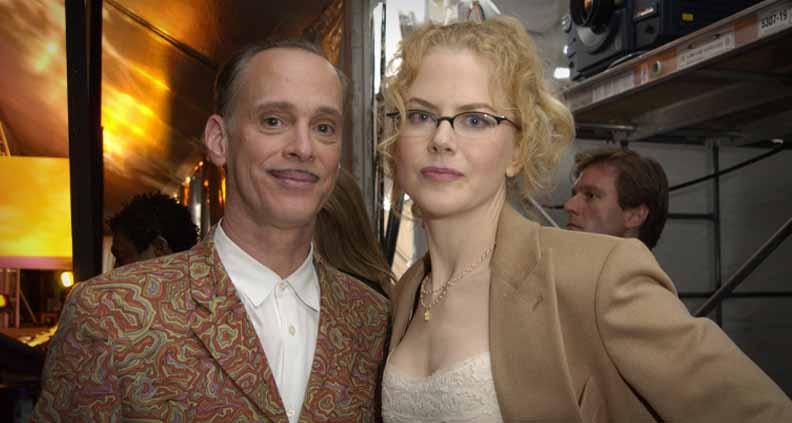
Picking up right where Buck Henry left off, counterculture icon John Waters became the Spirit Awards semi-permanent host for the first half of the 2000s, hosting the show four times between 2001 and 2004. These years saw a number of memorable moments, good, bad and cringe–see poor Brittany Murphy’s presenter meltdown in 2003, Mickey Rourke’s rambling defense of Eric Robert’s employability in 2009, or Derek Luke’s triumphant journey from Spirit Awards cater-waiter to Best Male Lead winner (also 2003). Plus countless others. Through this period the show was in its groove, thanks in part to a steady partnership with IFC, which had been broadcasting the ceremony on cable airwaves since the early ‘90s.
But! There were changes looming; subtle at first, then radical…
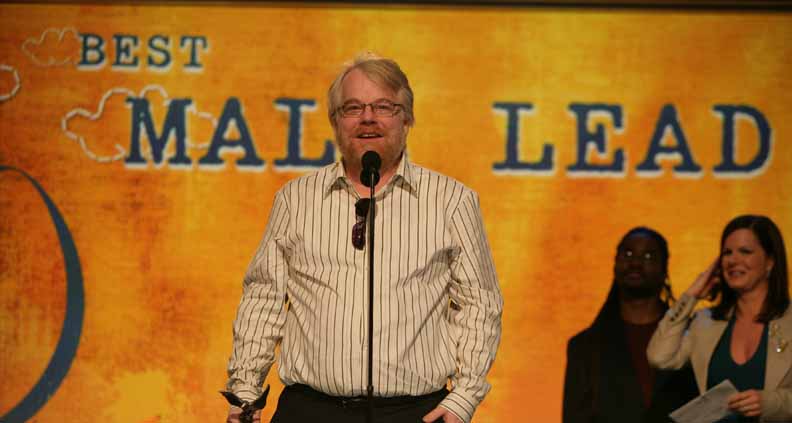
Concurrent with the boom of shows like Breaking Bad, Deadwood, The Wire, Mad Men, Dexter and the aforementioned Sopranos, so too emerged a new “alt-comedy” boom which like the indie music and movies of a decade earlier was by 2010 edging perilously close to the mainstream. And the Spirit Awards were watching.
By the end of the 2000s Spirit Awards hosting assignments were already being handed out more reliably to figures from the comedy world: Sarah Silverman (2006 and 2007), Rainn Wilson (2008) and a pair of British imports, Steve Coogan and Eddie Izzard (2009 and 2010, respectively). In 2010, IFC rebranded itself as an alt-comedy network (“always on, sometimes off”) and the tenor of Spirit Awards ceremonies evolved to match it, with a greater emphasis on comedy and absurdist televisual spectacle.
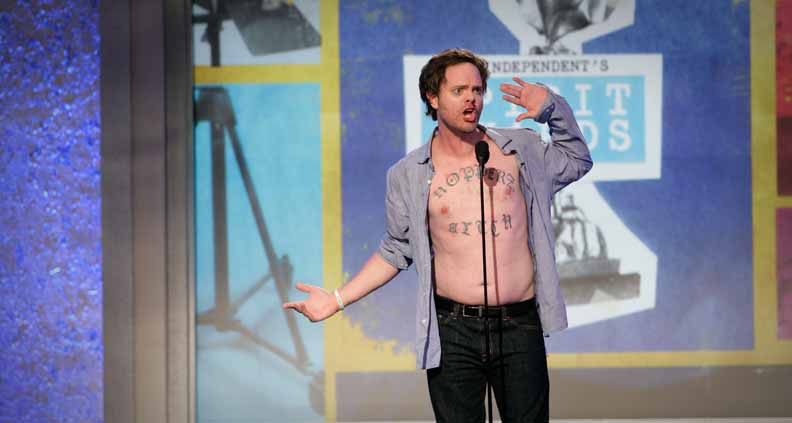
As the Obama Administration rolled on, funny hosts included Joel McHale, Seth Rogan, Andy Samberg, Patton Oswalt, Kumail Nanjiani, Kate McKinnon and Fred Armisen, co-hosting with Kristen Bell for the Spirit Awards 30th anniversary show in 2015. There were sketches and parodies and even an ear-splitting performance by ‘80s metal gods Anvil, subjects of 2010 Best Documentary winner Anvil! The Story of Anvil.
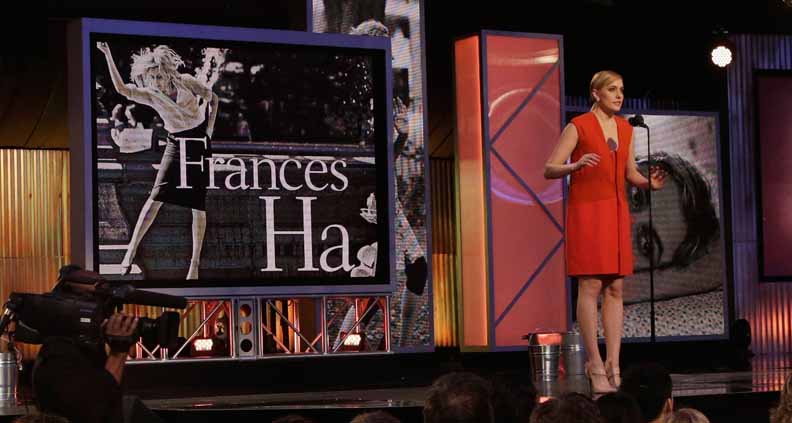
Meanwhile, the Venn diagram between the Spirit Awards and the Oscars was growing evermore circular, with winner overlap between the two shows becoming commonplace. Even so, the Spirit Awards regularly waded into waters reflecting a greater vision of inclusion, with top honors in the early 2010s going to diverse, daring projects like Precious, Short Term 12, Blue is the Warmest Color, Exit Through the Gift Shop, etc.
In 2016, history was made when Mya Taylor won Best Supporting Female at the 2016 Spirit Awards for her electric co-starring performance in Sean Baker’s sex worker farce Tangerine. It was the first win by a transgender actor at a major Hollywood awards show. As traditional notions of binary gender began to dissipate on a mass scale in the late 2010s, a conversation began behind closed doors at the Spirit Awards asking if perhaps there was a better way to do things. After examining the idea from all angles in consultation with leaders in the LGBTQIA+ community, the Spirit Awards introduced fully gender-neutral categories in 2022.

Following Harvey Weinstein’s fall from grace in 2017 and the #MeToo and #TimesUp movements, Film Independent and Spirit Awards doubled down on providing platforms for underrepresented communities. Weinstein, Brett Ratner and a few other deserving targets would also be savaged–brutally–in hosts Nick Kroll and John Mulaney’s opening monologue from 2018. The duo had first teamed up to host the year before, their 2017 monologue accumulating a whopping 3.3 million views on YouTube.
People were starting to watch the show in a big, big way–just not always on IFC. Since 2016 the show had been uploading winners’ acceptance speeches, monologues, sketches and other breakout segments in close(ish) to real time on Film Independent’s social media outlets, resulting in a whopping increase in the awards’ digital audience. With the IFC deal expiring in 2022 the show began livestreaming on YouTube in 2023–the proof of concept of which was (unintentionally) the interactive digital livestream of the show that happened in 2021, when business-as-usual was rudely interrupted by COVID-19.
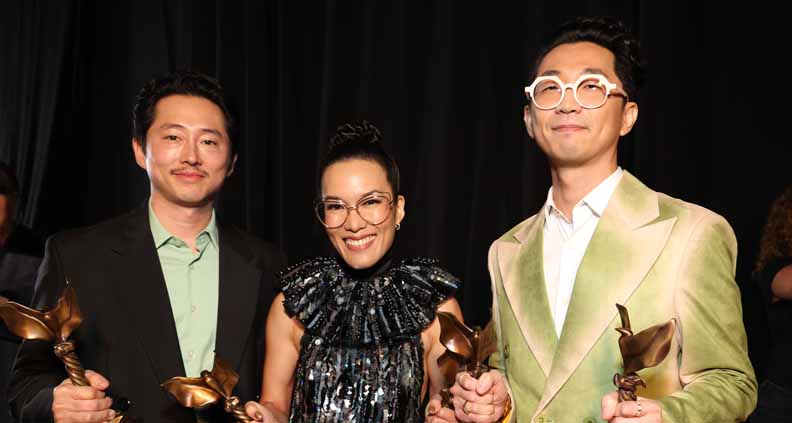
Post-COVID, the ceremony introduced another dramatic innovation: the introduction of TV and streaming categories, which were first given out during host Melissa Villaseñor’s plucky pandemic-year ceremony in 2021. Acknowledging the fact that the Peak TV era now gave idiosyncratic creators room enough to play through episodic storytelling–not to mention make a living–the Spirit Awards have since honored titles including Reservation Dogs, The Bear, I May Destroy You, Pachinko and Squid Game, among others. Perhaps the best moment? The Rehearsal (Best New Non-Scripted or Documentary Series) creator/star Nathan Fielder’s good-natured razzing of late Film Independent President Josh Welsh, whose passion, vision and authenticity guided the Spirit Awards’ many new progressive innovations and evolutions. (Miss you, Josh.)
With Hollywood and the movies it’s always just one damn thing after another. Strikes. AI. Wildfires. Red One. With no shortage of existential threats grinding down atop our beloved medium, there are still somehow more and more great movies every year–just ask anyone with access to our yearly tidal wave of Spirit Award screeners. The next 40 years are about as big a question mark for the world as has ever been, and of course that uncertainty exists in microcosm for independent film. But for as long as there are stories to tell and tents to be erected, the Spirit Awards will remain here to be shared.
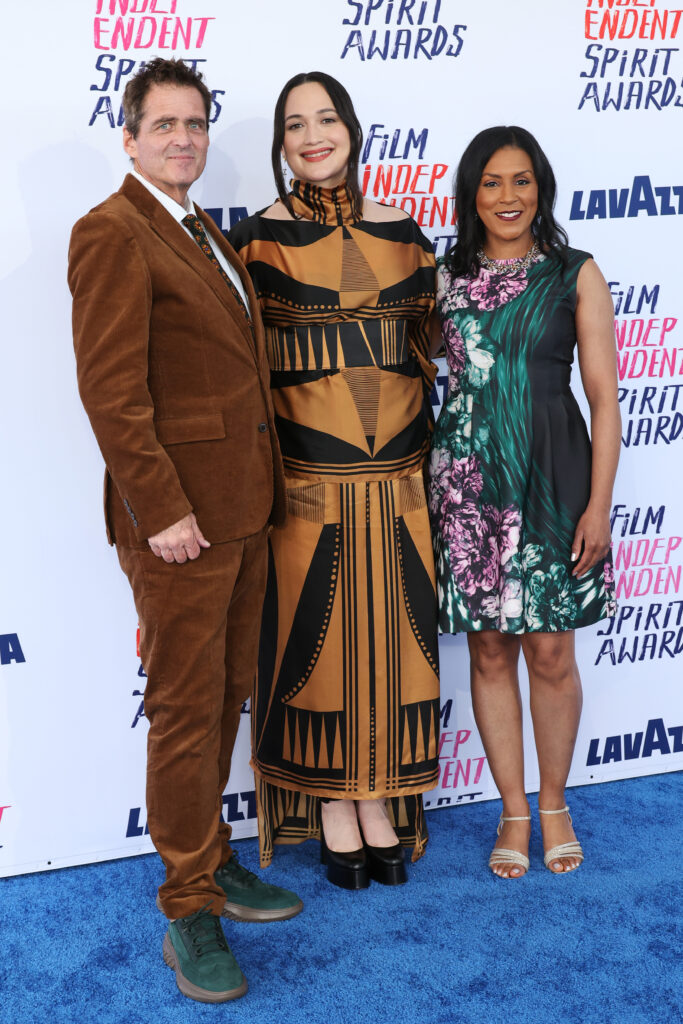
To see all this year’s nominees, click here. Remember to tune in to the 40th Film Independent Spirit Awards on Saturday, February 22, 2025, which will be helmed by returning host and Saturday Night Live alum Aidy Bryant. The show, taking place at the beach in Santa Monica, will be streamed live on the IMDb and Film Independent YouTube channels, and across our social platforms.
Film Independent promotes unique independent voices by helping filmmakers create and advance new work. To support us with a donation, click here.
More Film Independent…
A former member of the Film Independent staff, Matt Warren is a Utah-raised, Louisville-based writer, director and producer whose most recent work is the feature Delicate Arch, now streaming on Screambox and available to rent on all platforms. He has made numerous scripted and unscripted web series, and has worked as a film critic, entertainment journalist, humorist, editor, graphic designer and videographer. His favorite movie is The Night of the Hunter, directed by Charles Laughton.
Love It or Hate It: Our Favorite Valentine’s Day and Anti-Valentine’s Day Indies
To put it bluntly, Valentine’s Day is perhaps the most awkward national holiday. On the one hand you have lovely and joyful romantic partners eager to get their plans started, and on the other hand you have lovely but dissatisfied singles preparing to witness all the plans in action, right? No! There are also people who get together with their palentines and do something quiet or have an absolute rager, people who go to bars or clubs or parties for the sake of a good time, people who visit loved ones—who may have lost loved ones—to offer comfort and company, etc. Then, there are those of us die-hard cinephiles who don’t have a fulfilling holiday without popping in a film or two. Whether you have a valentine, palentine, or you’re a singleton, there’s something for everyone to enjoy under the “Sweet and Sour” sublist, and/or dislike (in a good way, of course) under the “Bitter and Dour” sublist. Turn down the lights, take out the desserts, and hit play with love.
Sweet and Sour
Desert Hearts (1985)
Director: Donna Deitch
Original Writer, Writer: Jane Rule, Natalie Cooper
Cast: Helen Shaver, Patricia Charbonneau
Why We Love It: Set in 1950s Reno, Vivian (Shaver), a literature professor from the big city, is fracturing from within as she finalizes her divorce in an unfamiliar place. Enter sweet and high-spirited Cay (Charbonneau), the remedy she didn’t know she needed; the next chapter in her life’s story. However, a fresh wound of the soul can only heal so much so fast. Unlike Cay, Vivian struggles with her emerging attraction to the same-sex, causing significant anxiety fueled by unwanted and intolerant attention. Still, Desert Hearts optimistically demonstrates that as soon as one heart-shaped door closes, another one a little bit more colorful could open up and lead to something meaningful. Classic dreamy tunes by Patsy Cline and Kitty Wells are just the cherry on top of the journey.
Mississippi Masala (1991)
Director: Mira Nair
Writer: Sooni Taraporevala
Cast: Denzel Washington, Sarita Choudhury
Why we love it: Mina (Choudhury), a South Asian woman with roots in Uganda, and Demetrius (Washington), a Black man from Mississippi, come from very different cultural backgrounds, but that doesn’t stop love from drawing them together. Set primarily in the deep southern state of Mississippi, their relationship is challenged by both of their families whose criticisms are based in bigotry. Moreover, basically everyone is challenged by the bigotry that surrounds them in American society; in the case of Mina’s family, Ugandan society, too. This multicultural story deals with several sociological and political issues, with Mina and Demetrius’s romance right at the center of it all. Tensions target their blossoming romance from all sides and corners, but unbeknownst to everyone, it’s not so easily wilted.
Before Sunrise (1995)
Director: Richard Linklater
Writers: Richard Linklater, Kim Krizan, Ethan Hawke, Julie Delpy
Cast: Ethan Hawke, Julie Delpy
Why We Love It: Sometimes it takes all the courage you can muster to spark a connection. For Jesse, it was inviting her to spend his last day in Europe with him. For Celine, it was trusting him and saying yes. Before Sunrise is what dreams of a swept-off-your-feet romance are made of, however through a more realistic lens. On a regular day in Vienna, they walk around the city, visit a record store, go to bars and restaurants, all while talking about everything to do with life and the world as we know it. Unsure if they’ll ever meet again, it’s the rush of their thoughts like rivers and growing chemistry that makes this title one of the most effortlessly romantic films you’ll see.
Beautiful Thing (1996)
Director: Hettie Macdonald
Writer: Jonathan Harvey
Cast: Glen Berry, Scott Neal
Why We Love It: If discovering your unpopular sexual orientation and getting bullied wasn’t enough as a teenager, imagine falling in love for the first time—all at the same time. Jamie (Berry) experiences this exact reality, Ste (Neal) being his object of affection who struggles more with his feelings towards Jamie. Unsurprisingly, as they grow closer, worry about getting caught increases, yet what makes their connection so touching is that they bounce back stronger than before. Beautiful Thing manages to capture a hopeful and sensitive portrait of young gay love, while also maintaining a sense of ease and comedy. Also, the supporting characters definitely give the film that extra kick.
Rye Lane (2023)
Director: Raine Allen-Miller
Writers: Tom Melia, Nathan Bryon
Cast: David Jonsson, Vivian Oparah
Why We Love It: Dom (Jonsson) is shy and highly sensitive. Yas (Oparah) is more upfront and out-going. They meet at a mutual friend’s art gallery, and soon learn that they’ve both just got out of serious relationships, inspiring them to spend a longer period of time together. As they learn more about themselves from the help of one another, they in turn also see the value in each other, making the film ever so charming to watch. Incredibly eventful, sharp in its filmmaking and quick-witted in its dialogue, Rye Lane is hands down one of the most stupendously crafted rom-coms of the decade so far. Its upbeat and vibrant atmosphere doesn’t let you go until the credits roll; a delightful treat you don’t want to pass out on.
Bitter and Dour
Ali: Fear Eats the Soul (1974)
Writer/Director: Rainer Werner Fassbinder
Cast: Brigitte Mira, El Hedi ben Salem
Why We Love It: One is never too old to fall in love for the first time, or as many times. In Emmi’s (Mira) case, a near-elderly German woman, her chance at a next great romance comes in the shape of Ali (Salem), a younger Moroccan stud with a heart of gold—for better and for worse. Set in 1970s Germany, these two lonely hearts quickly form a connection, which is just as quickly criticized and condemned by her family, friends, and local community. They do their best to persevere through the haze of prejudice that plagues their love, but how strong is their grip against the world’s wrench? Poignant and profound in its depiction of an “unconventional” relationship, Ali: Fear Eats the Soul may not be an easy watch, but it’s worth a watch.
Secretary (2002)
Director: Steven Shainberg
Original Writer, Writer: Mary Gaitskill, Erin Cressida Wilson
Cast: Maggie Gyllenhaal, James Spader, Jeremy Davies
Why We Love It: Warmth and tenderness generally comes to mind when imagining romance in its finest form. That’s how it’s commonly depicted on the screen, anyway, but certainly not the screen playing this title. For Lee (Gyllenhaal) and Edward (Spader), soft kisses and warm embraces are not nearly enough to satisfy their desires. The stars truly align when they meet, because their idea of love heavily involves alternative behavior—unlike everyone else around them, including Peter (Davies) who vies for Lee’s affections. Will she pursue a socially accepted love, or a love less traveled? Dark in its themes and alluring in its presentation of S&M, Secretary is sure to keep one’s perceived decency on the edge of its seat.
Let the Right One In (2008)
Director: Tomas Alfredson
Original Writer/Writer: John Ajvuide Lindqvist
Cast: Kåre Hedebrant, Lina Leandersson
Why We Love It: Tween love—or rather admiration, but who’s to say they know everything about love, anyway—is supposed to be cute and innocent. Then, there’s Eli and Oskar. They’re both twelve, except Eli’s been twelve for a really long time, as it so often goes when it comes to vampires. It would’ve felt like a crime to not include at least one film in this sublist that contains horror, considering how much more captivating stories that blend romance and horror can be, such as this one. The darkness that quietly looms over Eli and Oskar’s sincere and childish romance feels like poetry. Elegantly shot with grim surprises sprinkled throughout, here’s a contemporary gothic romance you want to let in.
Medicine for Melancholy (2008)
Writer/Director: Barry Jenkins
Cast: Wyatt Cenac, Tracey Heggins
Why We Love It: Micah (Cenac) just got out of a serious relationship, and Jo (Heggins) is still in one. What could’ve been left as a one-night stand, turns into a question of “What if?” It’s possible that Jo is more of a rebound to him, and it’s possible that Micah is just a quick-fix to her loneliness since her boyfriend is often away. Regardless, they give in to that bit of compatibility and poke around at the idea of them. You’re not supposed to root for them, yet despite the problematic circumstances, it’s obvious that in another lifetime they’d make a meaningful couple. Nuanced in its approach, how is the viewer to perceive this thought-provoking relationship? Perhaps not in the best light, but one must see for themselves.
Blue Valentine (2010)
Director: Derek Cianfrance
Writers: Derek Cianfrance, Cami Delavigne, Joey Curtis
Cast: Michelle Williams, Ryan Gosling
Why We Love It: Everyone has the right to pursue a good love, and it seems that’s how it often begins. Good, or even good enough. What we hear all the time, and simultaneously don’t want to hear, is that love fades. Of course, that’s not everyone’s story, and we hold onto those success stories like batteries to use when one’s relationship starts to feel off. We don’t want to hold onto the separation stories, however they continue to hold onto us, as seen with Cindy (Williams) and Dean (Gosling). Blue Valentine confronts the viewer with this undesirable possibility in its relentless depiction of a crumbling marriage where love used to live. As heartbreaking as it is, its realistic portrayal of the themes and composed pacing makes it befitting as a cautionary tale to experience.
Film Independent promotes unique independent voices by helping filmmakers create and advance new work. To become a Member of Film Independent, just click here. To support us with a donation, click here.
Keep up with Film Independent…
Imaginar Producers Fellows Spill on Why YOU Should Apply for This Year’s Residency
Working as an independent producer feels like a constant uphill climb that gets tougher with every change in the industry landscape. Developing projects can take years with little to no payment for the producers who are on the project who are each likely working on a slate of projects at all different stages. It’s difficult work in the best of circumstances. To continue our support of producers in 2022 Film Independent launched the Imaginar Producers Residency made possible by The Walt Disney Company and Searchlight Pictures, in collaboration with the National Association of Latino Independent Producers (NALIP). The residency is a nine-month program that supports three Latinx Producers where each Fellow receives mentorship, project specific support and a $50,000 grant to support their slate.
With this year’s applications closing this Friday(!), we thought it was a good time to highlight everything that the Residency has to offer. And who better to hear it from than two of last year’s Fellows. We spoke with Imaginar Producers Residency Fellows Nico Blanco and Maria Altamirano about their experience in the program.
Why did you apply to the program?
Nico Blanco: I applied to the program because I was looking for a place where I could grow as an independent producer, beyond moving forward a specific project. I was trying to understand how to make it more sustainable
Maria Altamirano: I applied because it’s rare to find a program that supports independent producers in a holistic way. Many fellowships focus on specific projects, but I was looking for something that would also help me grow in my career overall. After producing my second feature, I was entering a transitional moment in my journey, while grappling with questions around what was next and how to build a sustainable career. Imaginar’s approach, offering mentorship, financial support, and space to reflect on my identity and place as a producer in today’s industry, felt like exactly what I needed at that time.
How would you describe the program?
Nico Blanco: The program is looking to help Latine independent producers grow and further their careers, trying to erase the barrier of entry that there is for producers who are not independently wealthy.
Maria Altamirano: Imaginar is a game-changer for independent producers. It’s a residency that not only helps advance your projects but also invests in you: your career, your financial health, and your professional development. It provides creative support through conversations with the Searchlight team, financial coaching, career mentorship, and access to invaluable industry spaces. It’s the kind of support system that producers rarely get.
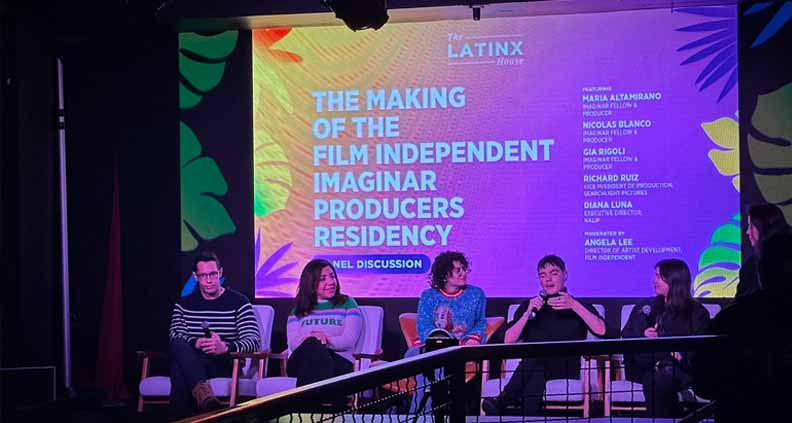
How did you change as a filmmaker from before to after the program?
Nico Blanco: I think I grew more comfortable with who I am as a filmmaker and definitely learned that what I say and do matters and has weight.
Maria Altamirano: I left the program with a stronger sense of confidence, not just in my producing skills but in how I navigate the industry. I refined how I communicate about my work, learned strategies for managing my time and business ventures, and deepened my understanding of how to advocate for myself and my projects. The experience also made me more intentional about the kinds of stories I want to champion and how I build sustainable career pathways. I also got a deeper understanding of the studio system’s approach to working with producers.
What was a note or piece of advice that stood out to you?
Maria Altamirano: One of the biggest takeaways was the importance of approaching my career with the same level of strategy and care that I apply to my films. Producers are often so focused on their projects that they don’t always prioritize their own long-term goals. The program reinforced the idea that investing in yourself – financially, creatively, and professionally – is just as crucial as investing in the work.
How did this program differ from other labs and programs you’ve participated in?
Nico Blanco: It was a program that was about me as a producer and an artist, not just about my projects.
Maria Altamirano: Most producer programs focus on a specific project, but Imaginar is unique because it supports both your work and your career. The structure and level of support was incredibly thoughtful, balancing creative, financial, and professional mentorship in a way that feels rare. It wasn’t about putting us into a box as independent producers but instead allowing space for us to approach our careers in imaginative ways, helping us explore new opportunities and build a sustainable path forward.
What is your relationship like with your cohort now that the program is over?
Nico Blanco: I see them not only as close friends and I believe future collaborators. I value their opinion and can’t wait to create something with them.
Maria Altamirano: We’ve built a strong bond and friendship, and I know I can turn to my cohort for support and advice. We continue to stay in touch, celebrate each other’s wins, and offer insights as we navigate our careers. Being in a program like this reminds you that you’re not alone in what you experience as a producer and it’s important to build a real sense of community and shared purpose.
What was one of the most memorable sessions in the program?
Nico Blanco: Being able to connect with agents was great, if there was a way to work on deepening those relationships further that would be great for the next cohort.
Maria Altamirano: The creative feedback sessions in general with the Searchlight team were a highlight. Having the opportunity to receive thoughtful, in-depth notes from the executives helped me see my projects from new angles and gave me practical ways to strengthen them. Other standout moments were participating in panels at the Latinx House at Sundance and the Congressional Hispanic Caucus Leadership Conference in DC. Both were incredible opportunities to share our experiences and expand our networks.
How did this program impact your career?
Nico Blanco: It allowed me to explore things I had never considered before and now I am someone who works in both the fiction and nonfiction realm.
Maria Altamirano: It came at a pivotal moment. The financial grant provided crucial support during a challenging time for the industry and personal transitions, and the mentorship helped me sharpen my approach to producing. I’ve expanded my network, refined my goals, and feel more confident navigating the industry as a producer.
What would you say to a friend or colleague to convince them to apply?
Nico Blanco: I’ll say that if they want to grow as an independent producer it will provide not only economic support but will also help them grow more confident in their work.
Maria Altamirano: If you’re a producer looking for a program that truly invests in YOU, apply! Imaginar isn’t just about supporting your projects, it’s about helping you build a long-term, sustainable career. You’ll gain invaluable mentorship, financial coaching, creative guidance, and a supportive community that will stay with you long after the program ends.
Applications for the 2025 Imaginar Producers Residency are now open, with a deadline of February 14 and a Film Independent Member deadline of February 28.
Film Independent promotes unique independent voices by helping filmmakers create and advance new work. To become a Member of Film Independent, just click here. To support us with a donation, click here.
Keep up with Film Independent…
The Best Sports Films That Aren’t About Sports
Whether you intend to watch ’the big game’ on Sunday or not, there’s just something about a great sports narrative. And no, we’re not talking about the NFL’s tired retread of a matchup we already saw two years ago between Kansas City and the Philadelphia Eagles— we’re talking about sports movies. Even if you’re more into watching film than sports— and let’s be honest, if you’re part of the Film Independent community, then there’s a good chance of that — the best sports films have something for everyone. There’s the irresistible underdog you can’t help rooting for. Determined characters coming together to face insurmountable odds. The framework— an individual or team in pursuit of greatness — is a classic hero’s journey. But as the films below showcase, the best sports stories aren’t actually about the sport at all. They’re about relationships, and all relationships at their core are about love, whether platonic, romantic, familial, or with the self. With Valentine’s Day coming up, what better way to merge the love of the game with the love of cinema, than to explore the best sports films that aren’t about sports (they’re about love).
CHALLENGERS
Director: Luca Guadagnino
Writer: Justin Kuritzkes
Cast: Zendaya, Josh O’Connor, Mike Faist
Why We Love It: If the best sports movies use sport as metaphor, then Challengers is the champ. Every scene in this movie is about power and sex— who has it, who doesn’t, who wants it… who doesn’t. Every relationship is a game, as we watch two friends turned rivals played by Josh O’Connor and Mike Faist compete in tennis and love, while the cool and calculating object of their affection, tennis prodigy turned coach Tashi Duncan (Zendaya), turns the tables on them both.
It’s designed to get you a little hot and bothered, milking the physicality and attractiveness of all involved. While I personally found the queer undertones between the two men a little too manipulative (Just make out already!), I have to give Challengers credit for crafting a power play menage-a-trois that is both original and dynamic. The intense, cinematic tennis matches act as conversations between characters, as they compete not just for the woman they both love, but for the love lost between them and the very sport itself. By the end of the film, both men are bruised and beaten, and the stakes of their final match have never been higher. Challengers explores how growing up changes your relationships— not just with friends and lovers, but with the very thing you loved so much you sacrificed everything to it as a passionate youth— ultimately questioning what in life is really worth fighting for.
LOVE & BASKETBALL
Writer/Director: Gina Prince-Bythewood
Cast: Omar Epps, Sanaa Lathan, Alfre Woodard
Why We Love It: Two words: Strip. Basketball. As a youngster obsessed with both basketball and cinema, this film left a huge impression on me after its initial release, and has cemented itself as a cult classic ever since. Omar Epps and Sanaa Lathan’s chemistry is off the charts in a story about two talented athletes, Monica (Lathan) and Quincy (Epps), who bond over a shared love of basketball. The film follows their complicated relationship from childhood to adulthood. It’s a compelling push-and-pull between two people who are perfect for each other, but their pursuits of individual glory keep driving them apart. Youthful lust and competition eventually give way to mutual love and respect, making it the most romantic film on this list by far. It also created the blueprint for the sports as sexual innuendo that made last year’s Challengers such a hit. Produced by Spike Lee, writer/director Gina Prince-Bythewood’s directorial debut won her the Independent Spirit Award for Best First Screenplay, while star Sanaa Lathan won the NAACP Image Award for Outstanding Actress in a Motion Picture. With the film, Prince-Bythewood wanted to normalize the idea that women, especially women of color, can and should aspire to having the career and relationships they deserve. Speaking about the film, she said, “Girls are often told you can’t have both, so I just wanted to normalize the belief that you can have both. I wanted to normalize girls like Monica, who were girls like me, who grew up playing sports and were… made to feel different”. While she went on to make bigger budget films like The Old Guard and Woman King, her passion and skill portraying ambitious, fully-realized women onscreen started here.
THE IRON CLAW
Writer/Director: Sean Durkin
Cast: Zac Efron, Harris Dickinson, Jeremy Allen White, Maura Tierney
Why We Love It: Sean Durkin’s (Martha Marcy May Marlene) devastating film is about brothers, masculinity, and wrestling, but at its heart, it’s about familial love, and how not expressing it can have devastating consequences. It’s also Zac Efron’s best performance. Based on the true story of the Von Erich brothers, a wrestling dynasty forever altered by unimaginable loss, the fictional version centers on Zac Efron’s Kevin, as he watches his younger brothers, played by Harris Dickinson and Jeremy Allen White, rise to fame in the world of competitive wrestling. While the patriarch Fritz is the walking definition of toxic masculinity, seizing every opportunity to undermine his sons and pit them against each other while pushing them to their limits, the brothers’ love and respect for each other is a joy to watch. The Iron Claw is a great example of cinema’s golden rule: ‘Show Not Tell’, and it’s often what’s not said that gives the story its power. Durkin wisely chooses not to exploit the family’s tragedies onscreen, focusing instead on the quiet agony of the aftermath, as surviving characters face the unimaginable. One of its most powerful moments comes from Maura Tierney’s underrated performance as a grieving matriarch struggling with what dress to wear to a son’s funeral. Without speaking a word, Tierney’s character conveys the unbearable cost of things left unsaid, things that could have possibly helped mend a broken family. Despite its heartbreaking story, The Iron Claw leaves us feeling hopeful, as Efron’s character finally confronts his father’s poisonous legacy by choosing to express love and vulnerability in front of his own sons. We can’t think of any greater display of strength, onscreen or off.
HUSTLE
Director: Jeremiah Zagar
Writers: Taylor Materne & Will Fetters
Cast: Adam Sandler, Queen Latifah, Ben Foster, Robert DuVall
Why We Love It: With a relatively simple set up, about a downtrodden NBA scout played by Adam Sandler discovering a player in Spain with the capacity for greatness, Hustle endears its audience with two tried and true techniques: 1. Utilizing Adam Sandler’s skills as a dramatic actor, and 2. Crafting a father-son dynamic between two underdogs who are both in pursuit of a dream against all odds.
Sandler’s Stanley is a jaded recruiter for the 76ers who, after a clash with his nepo baby new boss, played by Ben Foster, gets sent overseas on a grueling scout, where he stumbles across a local pick up game and discovers Bo Cruz, a raw talent on no one else’s radar. Sandler’s charm isn’t lost here, as he doggedly pursues Bo, a once promising player who initially gave up his dream of playing in the U.S. after his girlfriend got pregnant. Recognizing Bo’s untapped potential, Stanley brings him to the states to try and get him a real shot at the NBA, but Bo’s temper keeps getting in the way, as he’s arrested for aggravated assault at the airport and thrown out of the Combine when another player trash talks him. Despite this, Stanley decides to quit his job and focus all his energy on Bo, who initially lacks a consistent work ethic, but starts to blossom under his coaching. Stanley acts as a surrogate father to Bo, whose relationship with his own young daughter endears us to him, even as his inexperience and quickness to anger make him a challenging surrogate son. It’s an emotionally satisfying journey that proves all you need is one person to really see you and say yes.
WARRIOR
Director: Gavin O’Connor
Writers: Gavin O’Connor, Anthony Tambakis, Cliff Dorfman
Cast: Joel Edgerton, Tom Hardy, Nick Nolte
Why We Love It: An excellent film that flew under the radar during its release way back in 2011, Warrior is always worth a watch. It explores a fraught relationship between two estranged brothers, played by Joel Edgerton and Tom Hardy, as they compete against each other in an MMA tournament. Both want the prize money for different but equally valid reasons— Edgerton is a financially struggling family man with two daughters, while Hardy is a war hero who promises his winnings to the widow of one of his fallen comrades. Growing up, both brothers endured the abuse of their alcoholic father, played by Nick Nolte, and both still carry the pain from it. Their father has since gotten sober, but he still doesn’t have the trust of either son. When Tommy, played by Hardy, returns home to compete in the tournament, he agrees to let his dad coach him again, even though he hasn’t spoken to his family in years. The psychological and emotional wounds in Warrior are as raw and bloody as the ones the fighters give each other in the arena. If you’ve ever watched mixed martial arts, you know it’s a no-holds-barred brutal sport, and it provides the perfect outlet for years of simmering resentment and rage between the two brothers. The movie is one long fuse that burns all the way up to an explosive match up in which brother must fight brother for the ultimate prize. While Tom Hardy displays the terrifying savagery and brute strength he brought to roles like Bronson and The Dark Knight Rises, Edgerton plays the underdog in more ways than one, as he finally confronts the pain he caused the younger brother he abandoned all those years ago.
Like any sibling dynamic, the brothers are at odds as much as they are bonded in mutual trauma against their father, but one of the film’s most memorable moments comes when Nick Nolte’s character relapses and Hardy’s response is not anger but compassion, as he embraces and comforts his sobbing, drunken father. Warrior is a movie about healing, which is something we all need more of.
THE WAY BACK
Director: Gavin O’Connor
Writer: Brad Ingelsby
Cast: Ben Affleck, Al Madrigal, Janina Gavankar
Why We Love It: A subtle movie released during the pandemic with little fanfare, The Way Back proves director Gavin O’Connor’s talent once again for healing broken men onscreen. The story follows Jack Cunningham, played by Ben Affleck, a high school basketball prodigy who’s now an alcoholic separated from his wife and grieving the loss of his son. When his former Catholic school asks him to come back and coach the struggling basketball team, it provides an outlet for Jack to finally face his demons. The film doesn’t end in typical fashion, with Jack overcoming the odds and leading the unlikely team to a championship. Instead, he has a breakdown and finally decides to get help for his disease, while confronting his grief over his son and apologizing to his wife. It’s a poignant exploration of a man’s struggle against himself, and the sport of basketball provides the perfect vehicle for what is ultimately a battle of the soul. The script by Brad Ingelsby, with its complex explorations of masculinity and genuine love of basketball (also on display in his Emmy-winning series Mare of Easttown), doesn’t shy away from difficult subject matter. It’s a personal film in the best way, not just for Ingelsby, who comes from a family of basketball players and coaches, but for Affleck, whose struggles with addiction unfortunately became public due to his celebrity. This, combined with his highly publicized divorce at the time, created an internet obsession dubbed ‘sad Affleck’, and while the memes bordered on cruelty in their mockery of a real man in genuine crisis, Affleck’s ability to embrace even the darkest parts of himself makes this performance one of the best of his career. It’s a beautiful, redemptive film, and its bravery in tackling flaws head on with unapologetic vulnerability is exactly the kind of thing that makes cinema worth watching.
JERRY MAGUIRE
Writer/Director: Cameron Crowe
Cast: Reneé Zellweger, Tom Cruise, Cuba Gooding Jr., Regina King
Why We Love It: If a film is lucky, one of its quotes will make it into the cultural lexicon. Jerry Maguire, however, has not one, but three unforgettable lines (runner up goes to ‘Did you know the human head weighs eight pounds?’), showcasing its legacy as one of the best sport movies of all time. There are two relationships central to the film— the first is titular character Jerry’s difficult relationship with Cuba Gooding Jr.’s Rod Tidwell, a washed-up NFL receiver and the only client to stick by him after he leaves his company during a crisis of conscience. Jerry does something we should all do– question professional football’s problematic legacy, rife with abuse scandals and horrific injuries to the players, among other things. As a sports agent willing to do whatever it takes for his clients, however, Jerry is now at the mercy of Rod, who demands all his time and attention.
Watching Rod Tidwell, with his larger-than-life personality and an ego more fragile than a soap bubble, put Tom Cruise’s Jerry through the ringer is hilarious, if not infuriatingly relatable to anyone who’s ever had a difficult client or boss (aka everyone). It’s no wonder then that his demand for Jerry to ‘Show me the money!’ became an instant classic when it comes to catch phrases, and won Cuba Gooding Jr. the Academy Award for Best Supporting Actor.
But it’s the relationship between Rod and his wife, played by an excellent Regina King, that brings about Jerry’s personal evolution. As a man who only ever learned to love his job, their marriage, with all its ups and downs, its exuberant passions and unapologetic expression of them, teaches Jerry what real love looks like. Jerry, for all his ambition, is a man terrified of love, and this is the root of all his problems. His burgeoning friendship with his best and only client, however, leads him to finally see what was right in front of him all along— faithful employee and love interest Dorothy Boyd, played by Reneé Zellweger, the only other person to follow him on this new, perilous journey after he quits his company in spectacularly humiliating fashion. Jerry’s epiphany, that he needs his new wife Dorothy as much as he needs Rod, gave us a romantic declaration for the record books that includes the iconic line, ‘You complete me’, to which she replies, ‘You had me at hello.’
Jerry Maguire is the complete package, a movie about love and friendship that understands the people who stick by you at your lowest are the ones worth keeping around.
Film Independent promotes unique independent voices by helping filmmakers create and advance new work. To become a Member of Film Independent, just click here. To support us with a donation, click here.
Keep up with Film Independent…
Don’t-Miss Indies: What to Watch in February
Yes, we’re still in the warming glow of award season, but new movies never stop. Happily there are exciting new films to check out this February, including Cannes winners, cryptocurrency heists, cute little furry creatures, and some psychedelic horror.
ARMAND
When You Can Watch: February 7
Where You Can Watch: Theaters (Limited)
Director: Halfdan Ullmann Tøndel
Cast: Renate Reinsve, Ellen Dorrit Petersen, Øystein Røger
Why We’re Excited: This Norwegian psychological drama premiered at Cannes, earning a Caméra d’Or for first-time feature director Halfdan Ullmann Tøndel (grandson of Ingmar Bergman), pegged as one of ten European filmmakers to watch in 2015 by European Film Promotion. The story was inspired by the character of Elisabeth, Armand’s mother (Reinsve from The Worst Person in the World), who is called into school when her six-year-old threatens his classmate. The confrontation and ensuing revelations invite reflection on the way we form opinions about parents from the behavior of their children. With Reinsve carrying the demands of the role with an intensity that resulted in two months of bed rest according to an IndieWire interview, this deep character study is sure to be a compelling tale.
![]()
DELICATE ARCH
When You Can Watch: February 11
Where You Can Watch: Screambox
Director: Matthew Warren
Cast: William Leon, Kelley Mack, Kevin Bohleber
Why We’re Excited: Writer/Director Warren’s Utah roots are showing with this horror movie set in Arches National Park. Four college kids do mushrooms while camping under blue skies and red rocks, questioning reality (as they must) but then confronting real dangers alone in the wild. As a first-time feature filmmaker (and the beloved former Film Independent Senior Manager for Digital Content), Warren created “one gloriously unhinged mindfuck,” according to Cinepunx’s Justin Lore. An alum of Film Independent’s Fiscal Sponsorship program, this mashup of animation, live action and found footage promises to be a colorful descent into the bizarre and wonderfully unexpected.
ROUNDING
When You Can Watch: February 14
Where You Can Watch: Theaters and Streaming
Director: Alex Thompson
Cast: Namir Smallwood, Sidney Flanigan, Michael Potts
Why We’re Excited: If life as a rural medical resident isn’t scary enough, this movie compounds a young doctor’s past regrets with current stress that makes everyone wonder if James (Smallwood from American Rust) is gonna be okay. Escaping regrets from his previous residency in a big city hospital, James is now consumed with his new assignment. Frustrated with his fellow doctors’ ambivalence toward the convoluted case of a young asthma patient, James worries himself into a frazzled state; will his ambition to get her better cost him his own sanity? Rounding premiered at Tribeca in 2022, and since then Alex Thompson has also directed Ghostlight, which was nominated for a 2025 Spirit Award.
UNIVERSAL LANGUAGE
When You Can Watch: February 14
Where You Can Watch: Theaters
Director: Matthew Rankin
Cast: Matthew Rankin, Pirouz Nemati, Amir Amiri
Why We’re Excited: Winnipeg may be a strange destination for tourism (welcome to the historic Beige District), but it’s a great setting for a comedy of cultures. Influenced by Iranian cinema, Canadian filmmaker Matthew Rankin (The Twentieth Century) unfolds side-by-side illustrations of a city that speaks Farsi and French, that’s realistic and artificial, that explores Iranian culture at Tim Hortons. This quirky ensemble features kids in school beside an unlikely tour guide and an ex-civil servant (played by Rankin), resulting in “a completely unique breath of fresh air,” according to Tom Swift of The Mancunion. With 16 awards so far (two from Cannes), the juxtapositions and odd pairings make for a charming and satisfying surprise.
![]()
VERONA’S ROMEO & JULIET
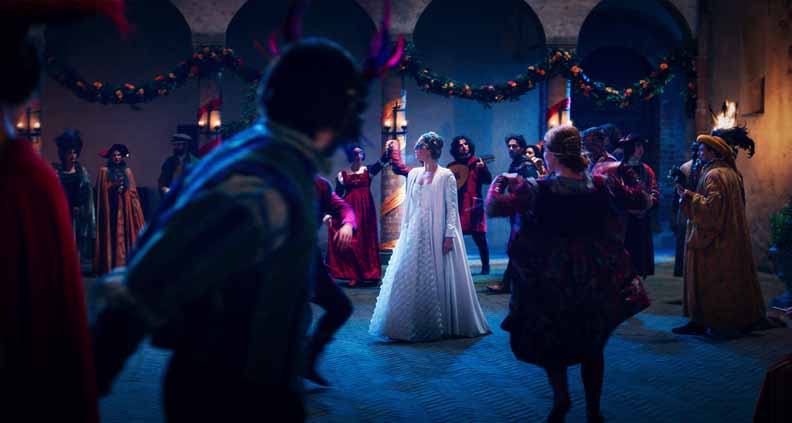
When You Can Watch: February 14
Where You Can Watch: Theaters
Director: Timothy Scott Bogart
Cast: Jason Isaacs, Dan Fogler, Rebel Wilson
Why We’re Excited: Following his last film about his father Neil, Timothy Scott Bogart (Spinning Gold) gives us a musical take on the real-life story that inspired Shakespeare’s Romeo and Juliet. Set in 1301, this trip to Verona is a full-blown original pop musical, featuring the vocal talents of Wilson (Pitch Perfect) and Everett (Napoleon), who play Lord and Lady Capulet. If music be the food of love, Verona will be an emotional feast. Said Bogart in a Pipeline Artists interview, “I just see the world through music. I can’t, nor do I want to, separate how music informs what we feel—and so those pieces draw me to them.”
![]()
DESIRE LINES
When You Can Watch: February 14
Where You Can Watch: Theaters (Limited)
Director: Jules Rosskam
Cast: Aden Hakimi, André Alan Pérez, Theo Germaine
Why We’re Excited: Using a hybrid of interview footage and scenic narrative, Rosskam (transparent) follows the lines of desire for men who are not only transgendered but homosexual. This through the lens of a 1970s bath house—a portal for male body acceptance and sexual awakening, where Iranian-American Ahmed (Hakimi from Yes We Candidate) time travels to connect with previous versions of himself. Desire Lines promises to be a tender, thoughtful and erotic exploration of transmasculine identity that is “a cinematic breath of fresh air,” according to Lauren Wissot at Filmmaker Magazine.
MILLERS IN MARRIAGE
When You Can Watch: February 21
Where You Can Watch: Theaters and Streaming
Director: Edward Burns
Cast: Gretchen Mol, Minnie Driver, Julianna Margulies
Why We’re Excited: Writer/Director Burns also acts in his fourteenth movie, featuring three siblings with demanding creative careers and unique challenges in their personal relationships. Film Independent held a virtual screening in November 2024 with Burns and his co-stars, Mol (Boardwalk Empire) and Margulies (The Good Wife) who play his sisters. Millers offers “sincere introspection of what people have to give up to balance their personal and professional ambitions and to accommodate a long-running partnership,” writes Stephen Saito in Variety. With Patrick Wilson (The Phantom of the Opera), Benjamin Bratt (Law & Order), and Driver (Good Will Hunting) rounding out the cast, this is a rare opportunity to see skilled actors explore relationship challenges later in life.
COLD WALLET
When You Can Watch: February 28
Where You Can Watch: Theaters and Streaming
Director: Cutter Hodierne
Cast: Raúl Castillo, Melonie Diaz, Josh Brener
Why We’re Excited: A lot more suspense than you might expect from a film that includes “Reddit” and “cryptocurrency” in the logline. Film Independent is hosting a screening on February 11 with Hodierne (Fishing Without Nets), who co-wrote and directed the twisting narrative of a motley crew taking back what’s theirs. After sinking his entire net worth into a scam, struggling dad Billy (Castillo from Cassandro) goes after the financial influencer who ripped him off, tracking him to a snowy estate decorated with fancy hunting gear. Castillo carries the desperate stakes of the movie, hitting idealism and boiling rage on the spectrum of human emotion. Maybe he doesn’t have much of a plan, but we’re rooting for him to figure it out.
THE LEGEND OF OCHI
When You Can Watch: February 28
Where You Can Watch: Theaters
Director: Isaiah Saxon
Cast: Helena Zengel, Finn Wolfhard, Emily Watson, Willem Dafoe
Why We’re Excited: Amid the stunning Carpathian mountains, Saxon takes us to a remote village in his feature debut. A young girl named Yuri (Zengel from News of the World) is raised to fear the dangers of the forest: bears, wolves, and something much worse. So when Yuri bonds with a baby ochi, she must defy everyone—including her militant father played by Spirit Award winner Dafoe (The Lighthouse) to reunite it with its family. Saxon shows off his commitment to worldbuilding, weaving a magical environment from precise Romanian locations as well as post-production art (which involved 200 matte paintings by his own hand). The rich visuals carry us along as we follow Yuri on a Goonies meets E.T. adventure that blends practical effects, puppets, animatronics and digital rendering for a nostalgic and sweeping fantasy.
*PROGRAMMER’S PICK* MY DEAD FRIEND ZOE
When You Can Watch: February 28
Where You Can Watch: Theaters
Director: Kyle Hausmann-Stokes
Cast: Sonequa Martin-Green, Natalie Morales, Ed Harris
Why We’re Excited: From Jenn Wilson, Film Independent Senior Programmer: Afghanistan war vet, Merit (Sonequa Martin-Green), is having a hard time adjusting to civilian life. She doesn’t want to attend the court-mandated PTSD group led by Dr. Cole (Morgan Freeman) or talk to her mom (Gloria Reuben), or deal with the fact her beloved grandfather Dale (Ed Harris) has Alzheimers. Good thing her dead friend Zoe (Natalie Morales) who served along with her in Afghanistan is always there to cheer her up and advise her on what to do. But is it actually Zoe or Merit that won’t let the two of them move on from the pain of what they experienced? This heartwarming and oftentimes hilarious, but poignant take on PTSD was written and directed as a tribute by director Kyle Hausmann-Stokes to two of his army veteran friends who made it back from the ground war, but didn’t survive the war in their own heads after they returned. Incredible performances by the two leads and supporting cast make this a film not to miss.
![]()
KEY
![]()
Film Independent Fellow or Member
![]()
Film Independent Presents Screening, Q&A
![]()
Microbudget
![]()
Filmmaker or Lead Characters of Color
![]()
Film Independent Spirit Award Winner or Nominee
![]()
Female Filmmaker
![]()
LGBT Filmmaker or Lead LGBT Characters
![]()
First-time Filmmaker
Film Independent promotes unique independent voices by helping filmmakers create and advance new work. To become a Member of Film Independent, just click here. To support us with a donation, click here.
Keep up with Film Independent…
A Brief History of the Film Independent Spirit Awards, Part One: 1986-2000
The 58th annual Academy Awards–presented by ABC on March 24, 1986 and celebrating the (alleged) best films of the movie year 1985–were watched by approximately 37.8 million television viewers. The Dorothy Chandler Pavilion, where the ceremony was hosted by the odd-throuple pairing of Alan Alda, Jane Fonda and Robin Williams. The evening’s big winner? Out of Africa, now regarded as one of the most turgid Best Picture winners of all time.
Two days earlier, March 22, a very different awards ceremony had taken place across town. The venue this time had been the rear ballroom of 385 North–a La Cienega restaurant. Here, amid a constellation of potted ficus trees and gold lamé drapes, unfurled the very first edition of the Film Independent Spirit Awards, hosted with casual luncheon hunkiness by Jagged Edge actor Peter Coyote.
The big winners? Martin Scorsese’s subversive black comedy After Hours (Best Feature, Best Director) and the Coen Brothers visually arresting neo-noir debut Blood Simple (Best Director, shared with Scorsese, Best Actor.) The most notable fashion moment? Inarguably cinematographer Haskell Wexler’s leather necktie.
As you already well know, the organization that would in later years be known as Film Independent first coalesced a few years earlier and was by 1986 up and running as IFP West. And since its inception, a regular part of the IFP West calendar had been its annual “FiNDIE” fundraising luncheon, which in its third year debuted a new awards element, the brainchild of then-IFP president Jeanne Lucas.
Introducing that debut ceremony, Lucas said: “This is really the first time, I think, that independent filmmakers have gathered together to celebrate the achievements of their own.” It would certainly prove the most enduring, as would the statuette designed by Carol Bosselman to serve as the awards’ prize and icon, the same design still used today. As Coyote explained in 1986: “The top features an abstract bird representing us–the independent filmmaker. It’s taking flight from a classical column, which represents the Hollywood establishment. And clutched in its talon is the ubiquitous shoe string.” In fact, shoestring imagery (shoestring budgets, get it?) would feature prominently in IFP West and Spirit Award iconography for years.
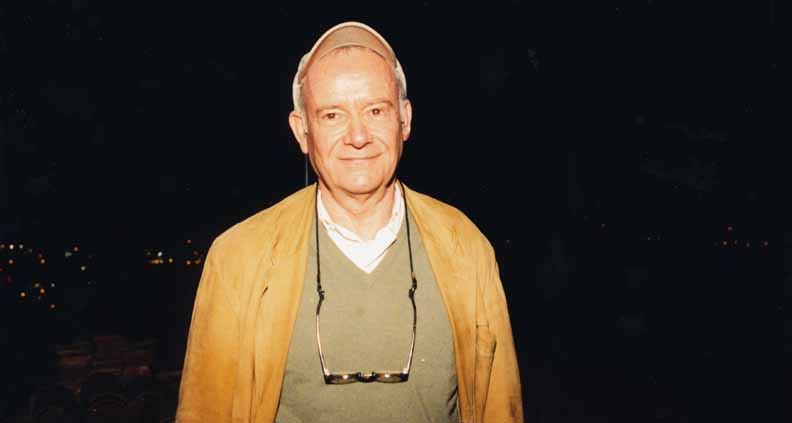
By its second year, the Spirit Awards had discovered a regular host in Buck Henry. A New Hollywood screenwriter and director best known for writing The Graduate and co-directing Heaven Can Wait with Warren Beatty as well as frequent hosting gigs on Saturday Night Live, Henry would host the Spirit Awards for eight consecutive years.
During this nascent era, the show moved out of the back of 385 North and bounced around a hotel ballrooms all across the city (The Hollywood Roosevelt, Beverly Hilton, etc.) before finding itself, somewhat bewilderingly, inside a large circus tent for its 1991 edition, erected in the parking lot of Raleigh Studios in Hollywood, where Martha Coolidge’s Rambling Rose bested fellow Best Feature nominees Homicide, My Own Private Idaho and Hangin’ with the Homeboys.
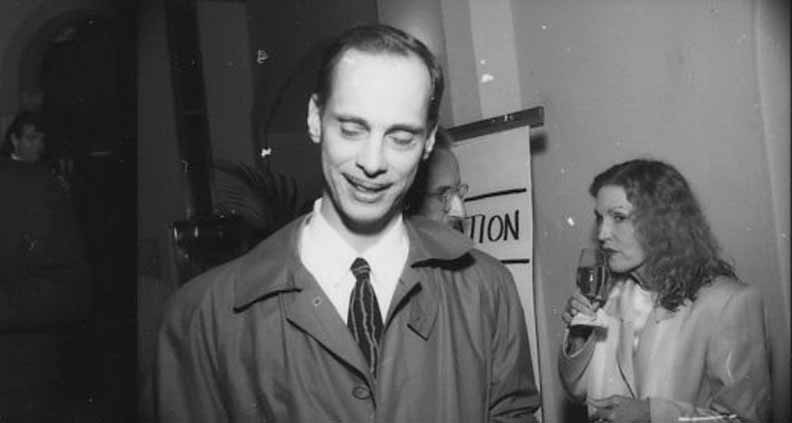
Somehow, the venue made sense. Filmmakers, after all, are nothing if not the tightrope-walkers, gregarious megaphone-barkers and cruelly exploited, fez-wearing elephants of the entertainment industry. The next year, 1992, a secondary component to the Spirit Awards’ physical identity was added when the tent moved to the beach in Santa Monica–the show literally placing itself as far away from the center of Hollywood as was possible before actively drowning its constituents or triggering a stingray frenzy. It was a potent metaphor, one that simultaneously supported the ceremony’s growing reputation as a casual, often irreverent hang. Once established, the Spirit Awards would only occasionally deviate from hosting its festivities on the beach, for better or worse.
A review of nominees from the Film Independent Spirit Awards earliest years–its 1980s era, into the early 1990s–reveals titles both indelible and influential (The Player! Bad Leitenant! Sex, Lies, and Videotape!) as well as obscure and essentially forgotten (Shag! Queens Logic! The Ballad of Little Jo!)–many of the latter aren’t available on streaming, and perhaps never even made the leap to DVD or Blu-Ray, victims of the purge that occurs at the margins of media any time a new consumer format is introduced. But! Through the Spirit Awards, these titles remain a part of the artistic record, honored in ways however fleeting or brief that preserve the possibility for rediscovery.
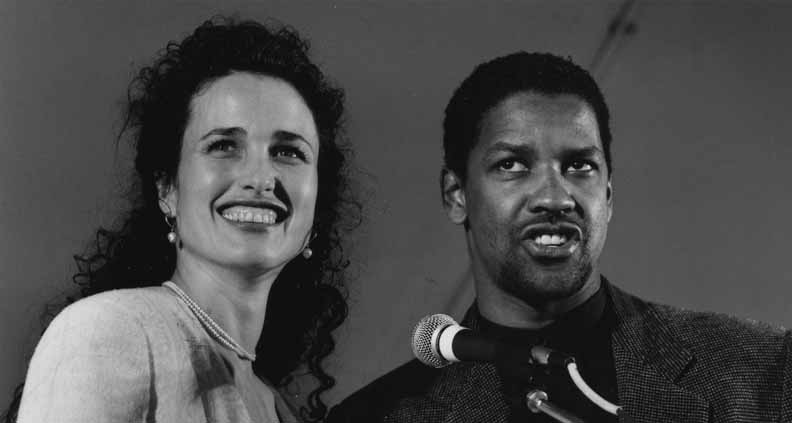
As gray suits and hair metal gave way to grunge music and heroin chic, the Independent Spirit Awards were fully established and poised to meet the cultural moment–a moment the awards were both in sync with and partially defined. Chief among them, Quentin Tarantino and Pulp Fiction’s triumph at the 1995 ceremony, his celebrity-auteur status signaled by a bright red suit jacket–practically a bullfighter’s cape, enticing the salivating Hollywood toro to charge him at his end of the amphitheater.
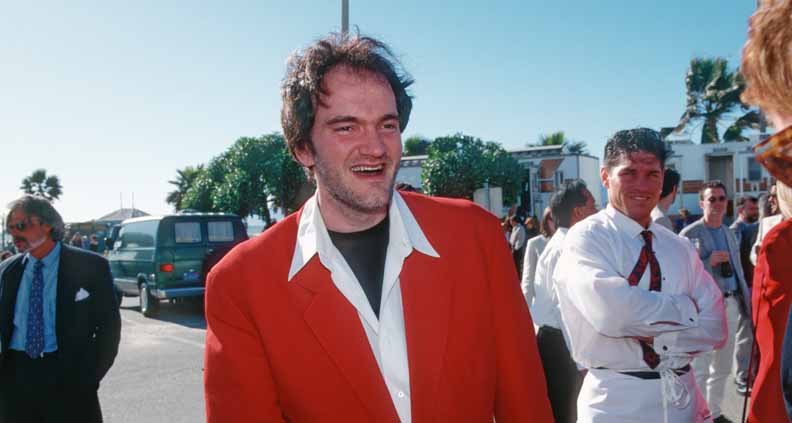
That 10-year anniversary ceremony was hosted by The Usual Suspect’s Kevin Pollak, taking over from the previous year’s host Samuel L. Jackson. In ‘95, Jackson won the Spirit Awards’ Best Male Lead trophy for Pulp Fiction’s Jules (Jackson was nominated for Best Supporting Actor at the Oscars for the same role that year, and lost.) In addition to Jackson and Pollak, the late-’90s Spirit Awards host roster included a wide range of emcees, including Jennifer Tilly, Queen Latifa and John Tuturro.
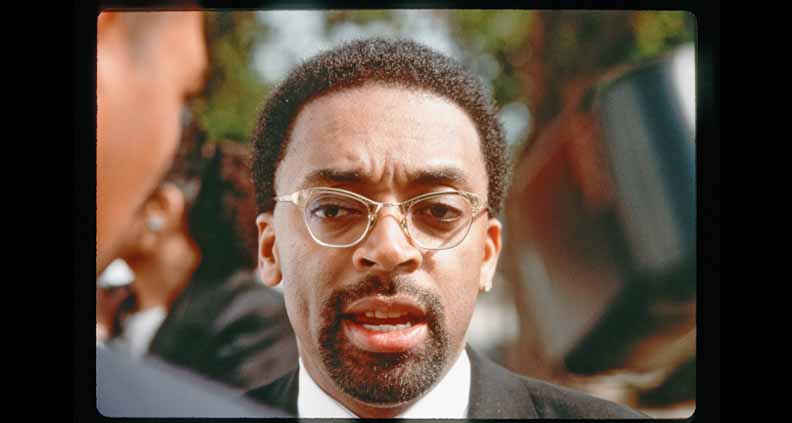
But even as independent film erupted into the mainstream during the mid-1990s, the Independent Spirit Awards remained future-focused, using categories earmarked for first-time writers, directors and breakthrough performances to spotlight the next generation of talent via some of their earliest projects. Here, you had Kelly Reichardt’s River of Grass, a 1996 Best First Screenplay nominee. You had Paul Thomas Anderson’s Hard Eight, nominated for Best First Feature in 1998. There was Tamra Jenkins’ Slums of Beverly Hills, Miguel Arteta’s Star Maps and Darren Aronofsky’s Pi. Plus debut performance nominations for Jeffrey Wright (Basquiat), Rose McGowan (The Doom Generation) and Rene Zellweger (Love and a .45) among others.
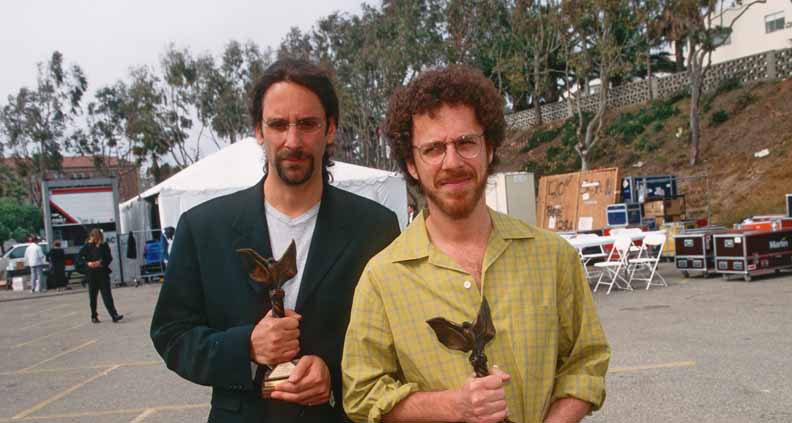
In the 2000s, the Spirit Awards–soon to officially be known as the Film Independent Spirit Awards, in order to make its relationship to the organization that produced it (and for which its primary purpose was to serve as annual fundraiser) more clear–would form strategic media partnerships that would make its reach even more pronounced, while at the same time refining its identity within the awards-o-sphere as colorful and comedy-oriented. But! You’ll have to wait for Part Two to learn about all of that…
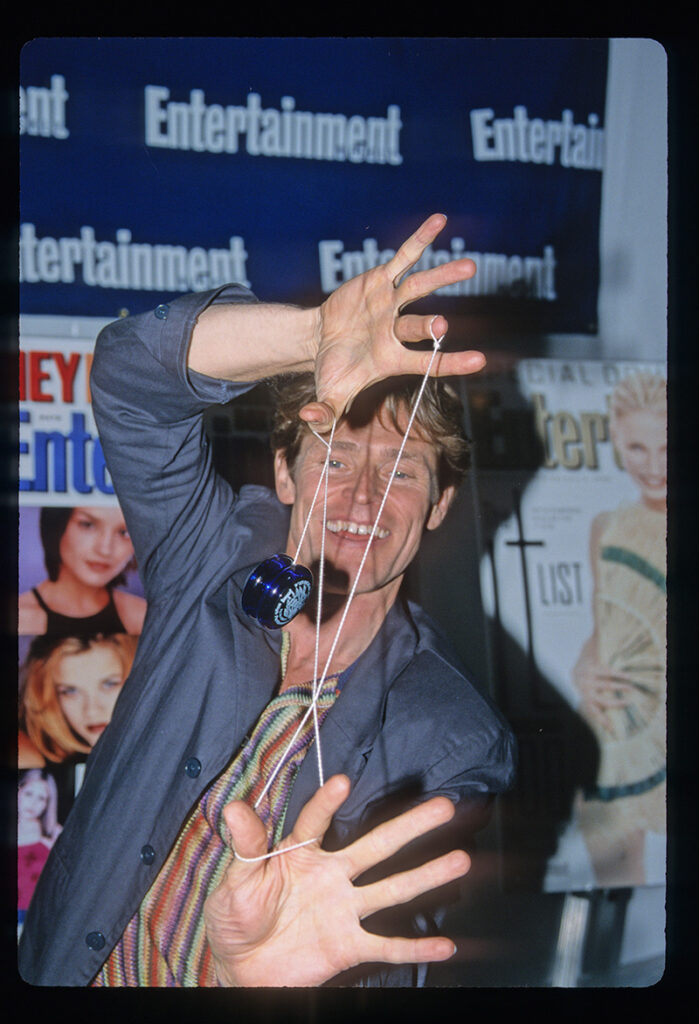
To see all this year’s nominees, click here. Remember to tune in to the 40th Film Independent Spirit Awards on Saturday, February 22, 2025, which will be helmed by returning host and Saturday Night Live alum Aidy Bryant. The show, taking place at the beach in Santa Monica, will be streamed live on the IMDb and Film Independent YouTube channels, and across our social platforms.
Film Independent promotes unique independent voices by helping filmmakers create and advance new work. To support us with a donation, click here.
More Film Independent…
A former member of the Film Independent staff, Matt Warren is a Utah-raised, Louisville-based writer, director and producer whose most recent work is the feature Delicate Arch, premiering February 11 2025 on Screambox and available for rental on all platforms. He has made numerous scripted and unscripted web series, and has worked as a film critic, entertainment journalist, humorist, editor, graphic designer and videographer. His favorite movie is Repo Man, directed by Alex Cox.
Video: Jude Law, Angelina Jolie, Pam Anderson & More Talk The Buzziest Films of the Year
If you’re anything like us, right now you’re catching up on the deluge of exciting films that came out at the end of last year. While watching those films, you might wonder how they were made. Fear not, we have you covered. Film Independent Presents has insightful Q&As from some of the buzziest films of last year with the people who made them. Check out Jude Law getting into the mind of a domestic terrorist, Pamela Anderson talking about giving acting everything she has, and Atlantiques director Mati Diop talking about why she turned to documentary for her new project. Plus, we’ll answer the question everyone is asking this award season: why they turned Robbie Williams into a monkey in Better Man!
THE LAST SHOWGIRL
Film critic Carla Renata speaks with director Gia Coppola, writer Kate Gersten and actors Pamela Anderson and Brenda Song about their new film The Last Showgirl. They discuss adapting the script from a the original play script, Anderson’s fears that this might be her last best shot, and yes that Jamie Lee Curtis casino scene.
THE ORDER
NPR’s John Horn speaks with writer Zach Baylin and actor/producer Jude Law about their new film The Order. They discuss why someone would be swayed by the vile white supremacist retoric of Bob Matthews, and how it can lead to violence.
MARIA
NPR’s John Horn speaks with actress Angelina Jolie, director Pablo Larraín, cinematographer Ed Lachman and production designer Guy Hendrix Dyas about their new film Maria. Larraín talks about delving into the mystery that is the great opera singer Maria Callas, and Jolie talks about returning to acting and how she re-engaged with her art.
DAHOMEY
Film Independent’s Kate Mason speaks with director Mati Diop about her new film, the Golden Bear winner Dahomey. She talks about why she wanted to capture the transfer of royal treasures from the Kingdom of Dahomey from France to back to modern day Benin. She talks about while researching, finding out that of the repatriation was happening in only a few weeks, and her choices to use a student debate to explore the topic, and to give the artifacts a voice
BETTER MAN
Euphoria creator Sam Levinson speaks with director Michal Gracy about his new Robbie Williams biopic Better Man. In this insightful discussion, the two talk about how the elaborate musical numbers were planned out, the relationship between animation and dance, and how the choice to turn the main character into a CGI ape freed up filmmaking possibilities that wouldn’t be available if working with a flesh and blood actor.
For over 40 years, Film Independent has helped filmmakers get their projects made and seen. The nonprofit organization’s core mission is to champion creative independence in visual storytelling and support a community of artists who embody diversity, innovation and uniqueness of vision.
Film Independent Members watch nominees and vote for the winners of the Spirit Awards. To become a Member of Film Independent and make your vote count for next year’s 40th Annual Spirit Awards, just click here. To support our mission with a donation, click here.
Keep up with Film Independent…
Disk Jockeys: How Beyond Video Opened a New Video Store in the Age of Streaming
Ed. Note: When I first started at Film Independent, I met with Josh Welsh, he said one thing he wanted to do was to reach out to people beyond the LA and New York film-scenes, because there were film lovers everywhere. He asked me for ways the blog could highlight all the great work that independent film lovers are doing across the country.
This new feature was my way of attempting that. Much like our Theater Crawl feature, Disk Jockeys will feature video stores across the country that fight the good fight and provide their communities with access to DVDs, Blu-Rays and VHS that can and can’t be found anywhere else. These stores preserve independent film history. This inaugural post is dedicated to our former president Josh Welsh.
***
Beyond Video in Baltimore didn’t pick an easy path. They opened in 2018, long after video stores had become a thing of the past in most mini malls. On top of that, they chose to be a mostly volunteer-run non-profit. One of the founders of Beyond, Eric Allen Hatch, wrote about the journey and how to recreate it in other cities. After reading that article, we wanted to learn more about opening the store and more importantly building a community around the love of movies. We spoke with two of the three co-founders, Eric and Kevin Coelho.
Tell me a little bit about the Baltimore film scene and why you felt a video store was something the city needed.
Eric Hatch: For about 30 years there was a place called Video Americain, where both Kevin and I and also Greg, the third owner of Beyond, worked for many years. And it’s the video store you can see in John Waters’ film Serial Mom. John was a regular there.
It had locations in D.C., but primarily Baltimore. And when that place started closing its locations in the early 2010s, a group of us, a much larger group, got together to try to save Video Americain.
The owner of Video Americain was actually someone who lived in Delaware. A great guy named Barry Solan, who used to run a repertory theater before he ran a video store. So our thinking was, here’s a guy who’s getting older in his 60s at the time, health problems, lives in Delaware. So it doesn’t make sense for him to schlep down to Baltimore for these diminishing returns. But maybe we can reboot this whole idea as a nonprofit.
And I think part of what gave us the confidence that it would work, although there were certainly fears and question marks and worries going into it, was that Baltimore has a really strong DIY ethos in film, but also the music scene, the art gallery scene, people really come out in support. And while Baltimore is gentrifying, it’s happening at a slower rate than other cities. It is a city where filmmakers, visual artists, and musicians can still afford to live and be.
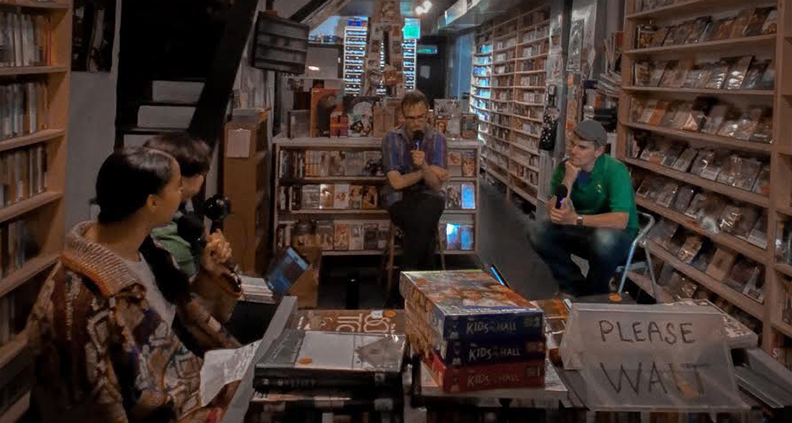
I worked for many years as a programmer at Maryland Film Festival, and now I started a new one called New/Next Film Festival. Greg, one of the other owners, works for the Parkway Theater, which is a project of Maryland Film Festival. I was just on the jury this week for Sweaty Eyeballs Animation Festival. One of our regular customers, Jimmy Joe Roche, runs a periodic screening series called New Works, which is all Baltimore-based filmmakers. So there really is a lot of things happening kind of on the streets as far as film culture goes in Baltimore, much more so than like Hollywood production.
There was a period where Hollywood would come here and get the rebate money and shoot some scenes here. Not so much anymore. It happens occasionally.
But most of the filmmaking that is here is like artists who live and work here, perhaps teach at the Hopkins or make the film programs and are really invested involved.
From the start, you decided to be a non-profit. Tell me about that decision.
Kevin Coelho: I think my last year at Video Americain was 2012. I started working there in 2003. So, I saw the full arc of kind of like the DVD boom of independent video stores, and then slowly year by year streaming and all the other competitors.
When we decided to close one of the two Baltimore locations, which I was one of the managers, I knew, and I was very passionate about, there’s still a place for video stores. A video store, I don’t think, is ever going to go out of fashion, having that physical element, the tactile browsing. There’s always going to be a passionate loyal customer base for that.
What’s going out of fashion is the business model of regular video stores and the business model of paying $4 per rental. You do the math, and there’s no way we could compete against, at this time, Netflix that was charging, $6 or $7 for the basic membership, and you had access to what they were advertising as an infinite number of movies and a video catalog.
So I knew that when I started doing this project, I didn’t want the stress of being a manager of finances get to me, because that was the worst part of managing the video store, trying to make ends meet, giving enough people enough hours to make their paychecks, and just being responsible for the financial end really gave me a lot of sleepless nights. I just wasn’t into revisiting that. So it was very important to me, and I think a lot of other people, that we reopened as a non-profit.
We didn’t have to worry about that, because we knew that if we got the doors open, we’d have a customer base and a fan base coming in. A lot of them have been loyal to Video Americain. I’ve been dealing with them on a customer/video-store-clerk relationship for over 20 years. So we knew it was going to be there.
I don’t think any of us were interested in balancing books and trying to make a profit out of this. It’s a labor of love. So that’s why we wanted to do the non-profit route.
You opened in 2018, during the peak-streaming era.
Can you tell me about how your marketing and your approach for getting people in the door and getting people excited about a video store.
Eric Hatch: The first thing we did to announce ourselves to the public was a Kickstarter.
And that also speaks to your last question about business model, because even though we were confident the people were there, we wanted to make sure they were going to support it, right?
There are existing video stores all over the country that are having trouble making ends meet. We didn’t want to be in that position from day one.
So we did a Kickstarter for $30,000, I think, to make sure there was a binary, yes or no. We chose Kickstarter versus another funding site in that, if we didn’t make it to that $30,000, we wouldn’t get $10,000 of donations that people expect us to work magic with. But we made our goal and exceeded it by a little bit, although it was a nail-biter.
Kevin Coelho: We met the goal with less than a week before the deadline. I was preparing myself that, oh, this isn’t going to happen.
Eric Hatch: Yeah. And we’ve been doing some social media before then, as well as some flyer-ing to accept donations of people’s physical media. There was this long period of us just hoarding movies at our houses of our own collection and things people had kindly donated, and this fear that, ‘Oh shit, this is going to be embarrassing. We told people we had this project and then we didn’t do it.’
All of which is to say, the Kickstarter was the make or break, and we made it.
We didn’t do the Kickstarter until we had a location set up. One of the biggest things we could do as far as announcing ourselves, was we, in our branding, collaborated with Bruce Willen of Post Typography, one of the big graphic-design and art guys in town. He designed our video swirl branding that was transposed into a mural on the front of the building, kind of like the Apple Records store the Beatles had in the 60s. Just a real attention getter that would make people curious.

Beyond that, we’ve done some flyer-ing, we do some anniversary parties, but Instagram has been our main source of engagement. It used to be Twitter a bit more, but Twitter is what it is right now. Instagram tends to be how we’ve connected with other video stores, tends to be where we drop what our new acquisitions and donations are.
The other thing we’ve done is we have a lot of public-facing wish lists. And this was a huge part of our project first, getting the collection together. And I think that that’s where Twitter was actually really helpful. We put out a call to the general public of, ‘We started to assess the collection we have before we open. Here’s some essential titles we don’t have.’ And it really took off. People were sending in discs from all over North America.
We opened in 2018 with a little less than 9,000 movies and we’re close to 38,000 now, with most of that coming from either donations or the membership fees. So that’s pretty incredible.
I think we’ve technically surpassed the size of the Video American collection that we were aspiring to preserve, although it took many years.
And that kind of gets to my next question, which is about the titles. Is there any specific type of films that you are looking for or titles that you are really happy that you stock?
What are you excited to share with the public?
Kevin Coelho: With opening in 2018 and, being 2024 now, the growth of these sort of boutique Blu-ray labels has been a really exciting time to be open to. And I think that’s really helped the excitement of stocking those titles.
In the beginning there was Criterion and Kino and Arrow. But now you have all these OCN labels of Vinegar Syndrome offshoots that speak to these niche cinema aficionados that like the obscure. And these labels are great because they’re releasing stuff that have been sitting in vaults for a long time.
I think CIP, the Canadian label, some of that stuff they’ve been releasing hasn’t been available in this country, or if it has, it’s been really shitty quality. So the fact that like there’s these passionate labels releasing these movies on physical media and having an outlet in Baltimore for that physical media to be seen and rented.
It’s really exciting for me that there’s still really exciting things coming out that, even being in the video store business since the early 2000s, really gets me excited that, ‘hey, oh my God, this has a physical release and this is awesome’. You know, this is great!
Eric Hatch: I would second all that. The other side of the equation is things that haven’t been ported over yet that are really obscure that we have in the collection.
On our House Favorites, we have a copy of Perfumed Nightmare, the 70s film from the Philippines. I’m sure that’ll get a deluxe Blu-ray release at some point. This was true about The Plot Against Harry, which did just get a nice Blu-ray. Things like that where, they weren’t on streaming, they maybe weren’t even on YouTube. You could trade on the dark web for them, but you weren’t going to see them unless you came to us.
There was a video store in the Philly area called Viva Video that closed during COVID. And the owner recently coordinated a donation of tens of thousands of movies that he had in storage, essentially from the closing of that store. We’ve been slowly going through the work of pruning out the duplicates and finding the gems that we don’t have in the collection yet.
It yielded a lot of VHS of things like Todd Solondz’ first film, Fear, Anxiety & Depression, which he’s denounced and which, for that reason, may never be ported over to Blu-ray; films by Carlos Saura and Mizoguchi and other filmmakers that just haven’t had DVD releases.
We’re trying to create the illusion that we have everything, that someone can’t stump us. And we’re so much closer six years in to being open to that, creating that illusion that I dared hoped we would be.
That’s an impressive collection. It makes me jealous even though I’m here in L.A.!
Eric Hatch: Yeah. I was really impressed with Videotechque when I was over there.
Videotechque! That’s my local! And then Vidiots just reopened, too. I am actually pretty blessed over here.
What was something that you did wrong that a lesson that you learned that if you could do it again, you would change?
Eric Hatch: I think there are a few things we narrowly missed. At first, we were going to open with parallel business models: you could do the old, rent for a new release for three dollars or you could do a monthly subscription.
And I think if we had done that, it would have been confusing for our customer base and the messaging would have been a lot less clean, and maybe we wouldn’t have succeeded.
And if we had charged late fees. I think we were all in agreement by the time we opened that we weren’t going to do that.But initially that was part of the plan, too. Everyone misses everything about video stores except late fees. The fact that we’re able to do away with that and that most customers are still good about getting their stuff back is awesome.
This was kind of a crazy dream that came true. It was a long process with a really amorphous group and sort of the trial and error of what the workflow was going to be, what the duties were going to be, who was in for the long haul.
I think that if someone were to try this in another area, you do need a big group of people and that energy. But I think coalescing clear definitions of who does what could be helpful. The long process of us kind of finding what each one of us either enjoys or will grudgingly do. ‘Well, who’s going to take out the trash?’ things like this.
The video store is a super fun project, but there’s still bills to pay. There’s still trash and recycling and things that are a little less fun. So, the more clarity you can have of those nuts and bolts, the better.
We do fiscal sponsorship, which I would advocate for anyone doing this unless they have someone who knows how to start a non-profit. Because if you’re fiscally sponsored, someone else can kind of anoint your project magically to be a non-profit.
The first organization we partnered with was a local one that we should have done maybe a little more research into. They were on their last gasp, and we had to jump ship and find a new one a couple of years in.
Fiscal sponsorship wasn’t a mistake. I highly encourage anyone to do that if they’re trying to open a video store, but making sure that you’ve got a stable, communicative, responsive fiscal sponsor is really important.
Why are video stores still important?
Kevin Coelho: I think it’s important for movies to have a space, you know? Anything anyone is passionate about, it’s important for those things to have a central location or just a place where you go and mingle with other people that are passionate about movies and physical media.
Movies have a place with movie theaters, and that’s great. And I go to the movie theater any chance I get and film festivals and so forth. But how many movies can you actually program in a movie theater on a given weekend?
Five, seven, if you’re lucky, and then how many movies are actually out there being shown in a movie theater across the country? Maybe 50, 55, you know? So what happens after they leave the movie theater? It’s important that there’s a physical space for them to reside permanently in a collection.

And I think that that’s where movie stores are really important; to have that back catalog, to have a place where you could find movies that, after their tenure in a movie theater, can live on. Of course, there’s all these streaming sites and so forth, but if you’re not one of the top 25 movies that they’re really pushing on their algorithm, you’re going to be forgotten about, and you’re going to go in this sort of limbo-ish area, and hope that in five or ten years, someone discovers your movie, and it becomes a cult classic, and then it’s pushed back into the forefront of the public consciousness.
But I think without a physical movie store or an archive or some sort of library to really push movies, it’s easy for a movie to just kind of like fade away into obscurity. So I think that’s an important reason why.
Eric Hatch: Yeah, I second all that and would also say, zooming out, video stores are fun, you know, fun and fulfilling. Shopping online for movies, whether it’s looking for sales on different corporate sites or whether it’s browsing for something to watch on a streaming service, that’s screen time and it’s exhausting rather than fun.
Being in a video store in a physical space. We see it every day we’re open where someone wanders in, maybe just a curiosity seeker, maybe they’re visiting town and just wanted to be back in a video store, but either way, we hook them a bit more than they expect it, because it really it really feels nice.
Most images people have of video stores now are Blockbuster, which I personally am not nostalgic for. I understand why some people are nostalgic for, but that was a corporate space. It was kind of a sterile space. People are nostalgic for the smell. I’m not.
But this is not that. This is a mom-and-pop store with tens of thousands of movies, feels more like a used bookstore, used record store than it does Blockbuster. And it’s just a stimulating place to be in.
And whether it’s someone experiencing it for the first time in their life or experiencing it for the first time in 15 years, you see them light up. We can put it into words, but it’s really a feeling more than a word.
Piggybacking on what Kevin was saying, access– in a video store, it’s all under one roof. Corporations are trying to steer you towards their product, but by doing that, they’re also fragmenting the landscape of film so that you have to have a dozen different subscriptions and you have to research who owns your favorite movie or your favorite series and then figuring out if you can steal a password or get a free trial or if you owe them 14 bucks to watch one episode of Freaks & Geeks or something. That’s not fun, and that’s not access.
Talking again about the film scene in Baltimore, we see the way more people light up about film and become film enthusiasts or even filmmakers because of access. If all they have access to in their house is Netflix and Amazon Prime and Hulu, yes, you can find amazing things that way, but you have to work. Here you have to work not to walk home with really fascinating movies and to have fun in the shopping browsing experience.
For over 40 years, Film Independent has helped filmmakers get their projects made and seen. The nonprofit organization’s core mission is to champion creative independence in visual storytelling and support a community of artists who embody diversity, innovation and uniqueness of vision.
Film Independent Members watch nominees and vote for the winners of the Spirit Awards. To become a Member of Film Independent and make your vote count for next year’s 40th Annual Spirit Awards, just click here. To support our mission with a donation, click here.
Keep up with Film Independent…
FiSpo Updates: Row of Life, Chasers, The Ice Cream Man & She Cried That Day
With Fiscal Sponsorship, independent films and their creators can accept sponsorship as if they were a non-profit through Film Independent. The program supports an inclusive variety of projects, narrative and nonfiction, shorts and features, as well as the occasional new media project, special event or advocacy initiative. Our monthly Fiscal Spotlight column introduces new fiscally-sponsored projects worth supporting.
Naturally, we want to see the fruits of all that awesome sponsorship, so today we’re checking in with four sponsored projects to see how there doing with another FiSpo Update.
ROW OF LIFE
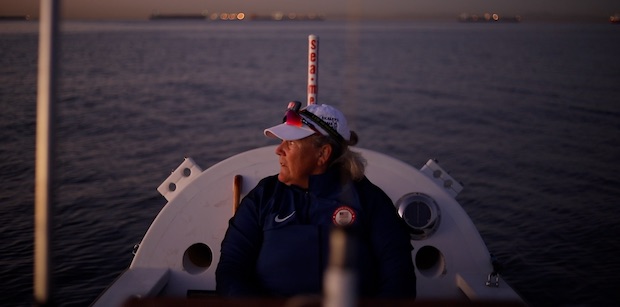
Project type: Nonfiction Feature
Project status: Distribution
Filmmakers: Soraya Simi, Nicholas Weissman
Synopsis: Row of Life is a feature documentary that follows Angela Madsen, a former Marine, 3x Paralympian, and renowned ocean rower, on her attempt to solo row unsupported from LA to Hawaii. Row of Life captures the year before the row and her preparation alongside her wife as well as the journey from LA to Hawaii – up until they unexpectedly lose contact with her.
Update: We’re excited to share that Row of Life will be premiering at the 40th Santa Barbara International Film Festival, followed by Big Sky Documentary Film Festival, and the upcoming Ocean Film Tour. Along the films journey, Film Independent has been integral in supporting the film, connecting us with our key investor, advocating for the film, and supporting us as a fiscal sponsor as we received finishing fund grants.
In addition, Our production team has also expanded to include Executive Producer Sue Bird — 5x Olympic Gold medalist, and partner to soccer player Megan Rapinoe — along with her company TOGETHXR, founded by Olympic medalists Alex Morgan, Chloe Kim, and Simone Manuel – which focuses on amplifying women’s sports stories as well as advocating for the LGBTQ community. Their partnership in addition to our CoProduction partner TIME Studios, not only reflects a true authenticity to the narrative, but validates Angela and her athletic feat on a global scale, and increases the reach of the film immeasurably. We’re currently represented by Sophia Heslov at WME and will be taking the film to market over the coming weeks.
CHASERS
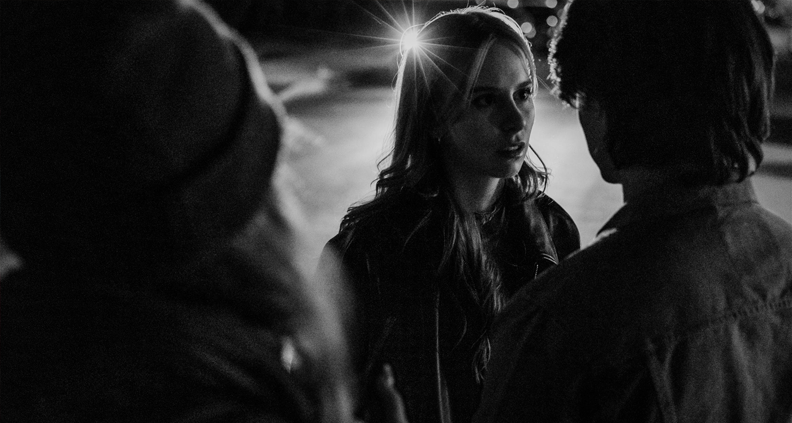
Project type: Fiction Episodic
Project status: Festivals
Filmmakers: Erin Brown Thomas, Ciarra Krohne, Olivia Haller, Elle Shaw, Beth Napoli
Synopsis: Set against the backdrop of an LA house party, Chasers follows a young dreamer who was recently manipulated into an unwanted sexual encounter with her crush. To cope with the abuse, she seeks to define and solidify their relationship.
Update: The Chasers team is thrilled to announce our World Premiere at Sundance 2025 on January 28 as part of the Episodic Showcase! We’re also celebrating a rare “double dance” achievement, with Chasers screening at Slamdance 2025 in February. This milestone has been accompanied by incredible coverage across every major trade, including Deadline, Variety, Hollywood Reporter, and Screen Daily.
Indiewire exclusively unveiled our trailer, with Alison Foreman describing the pilot as “a vibrant and self-reflective thesis on the cost of paying your dues in an industry relentlessly intent on taking more than its fair share from your soul and psyche.” Director Erin Brown Thomas shared her perspective with Indiewire, saying, “Entertainment, much like toxic relationships, loves to dress up exploitation as opportunity.”
We’re honored to share this deeply personal story with audiences, shining a light on the subtle manipulations of ambition and the sacrifices demanded in pursuit of a dream.
SHE CRIED THAT DAY
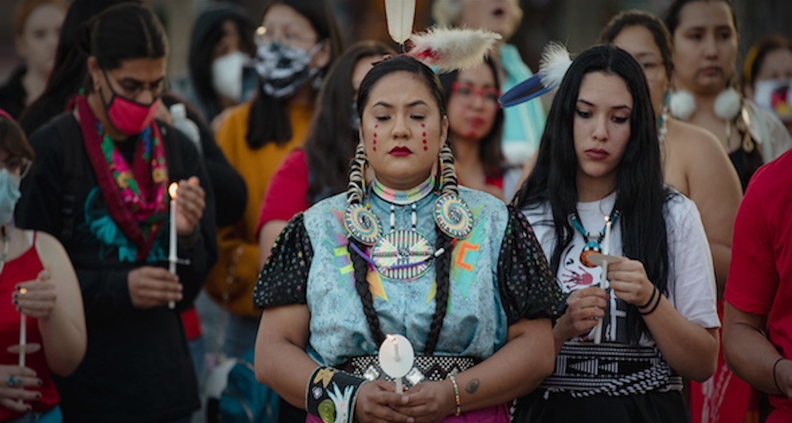
Project type: Nonfiction Feature
Project Status: Completed/Distribution
Filmmakers: Amanda Erickson, Stina Hamlin, Tracy Rector
Logline: Christine Means and her family have spent years questioning the circumstances surrounding her sister’s death. In 2019, a renewed sense of hope for justice places Christine at the center of the Missing and Murdered Indigenous Women and Relatives movement in New Mexico. Against all odds, this is a story of love, spirit, and the unwavering power of Indigenous women and allies who refuse to let their loved ones be forgotten.
Filmmakers’ update: She Cried That Day will be making its World Premiere at Big Sky Documentary Film Festival on February 20th, we hope to see you there or on the road as we make our way into the world! We couldn’t have done it without the support from Film Independent Fiscal Sponsorship and Documentary Lab. We are also proud to announce that Tracy Rector and Stina Hamlin of 4th World Media will be joining our family as Executive Producer and Supervising Post Producer. It has been a long journey, but one made easier with support from the vast network of brilliant filmmakers in the Film Independent extended family. Thank you for bringing us into your circle of care! We invite you to be a part of this journey by donating to our project and staying updated on our outreach and impact through our website. Your support is crucial in bringing awareness to this issue and supporting those with missing loved ones.
THE ICE CREAM MAN
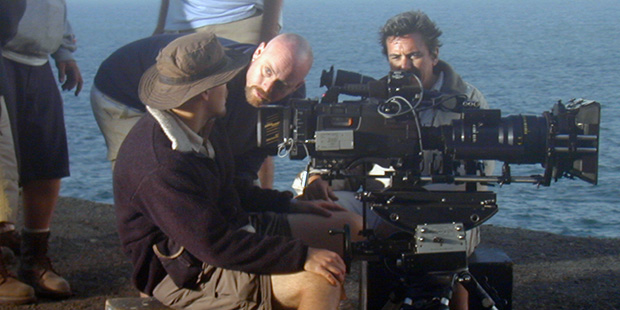
Project type: Fiction Short
Project status: Festivals
Filmmakers: Robert Moniot, Greg Malone
Filmmakers Update: The Ice Cream Man has been shortlisted for the Oscars Live Action Shorts. We are thrilled for this honor, given that we delivered a final version just in time for the qualifying run in Los Angeles in September. We have appeared in several festivals, winning audience awards at Indy Shorts and the Naples International Film Festival. Additional festival appearances are scheduled in Palm Beach, Key Biscayne and Boca Raton, FL; Sedona, AZ; and more where we have been accepted but formal announcements have not yet been made. In addition, our curriculum development with The Anne Frank Center is in full swing, and initial responses during test runs have been strongly positive. With the help of FI Fiscal Sponsorship, we have been able to craft a moving story that needs to be told, and we are on the cusp of getting it out to the world…mostly for free. We are still raising funds for our Oscar push and the development of the curriculum, including additional video and museum quality assets to support the storytelling.
Film Independent’s Fiscal Sponsorship program gives nonprofit funding to independent filmmakers and media artists. The participating filmmakers and projects express a uniqueness of vision, celebrate diversity and advance the craft of filmmaking through the creation of these special works. To see all of projects that are part of our program, visit our Sponsored Projects page.
For more information about any of our Film Independent programs (including Fiscal Sponsorship) and how to apply to them see our Artist Development page.
For over 40 years, Film Independent has helped filmmakers get their projects made and seen. The nonprofit organization’s core mission is to champion creative independence in visual storytelling and support a community of artists who embody diversity, innovation and uniqueness of vision.
Film Independent Members watch nominees and vote for the winners of the Spirit Awards. To become a Member of Film Independent and make your vote count for next year’s 40th Annual Spirit Awards, just click here. To support our mission with a donation, click here.
Keep up with Film Independent…
(Header: Chasers)
An Independent Icon: David Lynch, 1946-2025
The hits keep on coming. 2025 has been a difficult year so far, and now the independent film community mourns the loss of one of its patron saints, Independent Spirit Special Distinction Award winner David Lynch. He was 78.
Born a year after the end of World War II, the man behind Twin Peaks, Blue Velvet, Eraserhead, Mulholland Drive, and others knew how to delve deep into the post-war American psyche. His films had their own internal logic that worked on a subconscious level, while still being exciting, funny, and humanistic. Then there was the cosmic dread, which was one of Lynch’s signatures. He externalized anxieties into celluloid nightmares, whether that was the fears of fatherhood in Eraserhead, the unease about small town values in Blue Velvet, or the “possibility that love is not enough,” as stated by Major Garland Briggs in Twin Peaks.
He was the definition of a cult artist, and his cult seemed to include anyone and everyone who seeks to experience the unexpected, both on a visual and subconscious level. Part of the joy of watching a Lynch film is talking about the wildness and weirdness you just witnessed with your fellow cinephiles, hopefully at a diner late at night over some ‘damn fine coffee’. In fact, Twin Peaks was one of the first TV shows to have watch parties, where people gathered each week to find out who killed Laura Palmer. Of course, the show’s appeal goes beyond the standard murder mystery. Twin Peaks wasn’t afraid to go big, posing deep questions about spirituality, psychology, and cosmic evil, all while taking delight in the small things like cherry pie or a cup of ‘damn fine’ coffee. These sensibilities reflect Lynch himself; his work explored challenging ideas with no easy answers. He often stated that he himself didn’t know what his films were about– and that was part of the fun. He believed each person found different meanings in art.
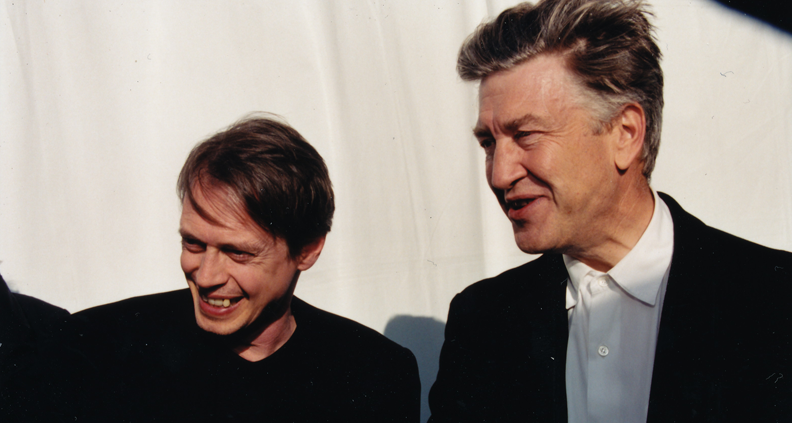
Part of Lynch’s appeal was that he walked the line of being the ultimate everyman and a complete original. There are stories of him going to the Burbank Bob’s Big Boy every day for seven years for coffee and a chocolate milkshake. He made completely mundane YouTube weather reports for years. He was a proponent of transcendental meditation and credited it with getting him in touch with his creativity.
Lynch had a successful but sometimes rocky relationship with Hollywood. After the success of Eraserhead on the arthouse circuit, he was contacted by Mel Brooks’ company to make The Elephant Man. The film was a huge success and led to eight Oscar nominations, taking Lynch from ‘arthouse’ to bonafide Hollywood director. His next film was the big budget adaptation of the sci-fi classic Dune. He clashed with the studio, and after the film failed to live up to their expectations, the studio recut the film. Lynch took his name off the project, giving it the Alan Smithee treatment, changing the name of the screenwriter to the pseudonym “Judas Booth”.
The success of Twin Peaks created similar difficulties. Just about everyone, including the powers that be at ABC, wanted to know, “Who killed Laura Palmer?” and hoped for an answer by the show’s first season finale. Lynch strongly disagreed and held the execs off for a time. He finally acquiesced and revealed the murderer halfway through the show’s second season. The show lost steam and viewers shortly after, as the creative team had to find what the show would look like now that the show’s central mystery had been solved. At the end of the second season, they found a way to bridge the new storylines with parts of older mysteries, bringing back Bob and the Black Lodge, but by then it was too late. The show was canceled after two seasons. The 2017 revival saw Lynch clashing with its new network, Showtime. He initially decided to abandon the project after a disagreement over budget and length. In the end, Showtime agreed to a deal, and Twin Peaks returned to almost universal acclaim, being the only TV show on Sight and Sound’s ‘Best Films of the 21st Century’ list.
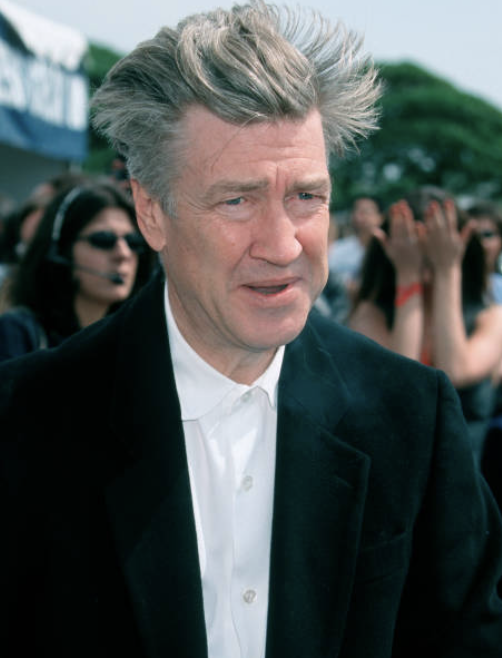
Despite these commercial successes, Lynch shined the brightest when he was making independent projects. He shot his jealousy fever dream The Lost Highway at his own house, and his 2006 Inland Empire was one of the first major releases to be shot entirely on digital cameras. After Dune’s failure, Lynch could only get $6 million to make his neo-noir thriller Blue Velvet, but those constraints gave him freedom, and the result was one of Lynch’s defining films, exploring the darkness and violence lurking beneath the innocent facade of suburbia.
Lynch died of emphysema. In a statement he made announcing the illness last year, he said, “Yes, I have emphysema from my many years of smoking. I have to say that I enjoyed smoking very much… but there is a price to pay for this enjoyment, and the price for me is emphysema.” Honest and unafraid of life’s dark side till the very end.
As well as being a filmmaker, Lynch was a painter and musician. He was a three-time Film Independent Spirit Award Nominee and won the Special Distinction Award in 2007. He was married four times and is survived by his four children. In an announcement on Facebook, they wrote, ‘There’s a big hole in the world now that he’s no longer with us. But, as he would say, ‘Keep your eye on the donut and not the hole.’ No matter what that last part means to you, we know Lynch would approve.
For over 40 years, Film Independent has helped filmmakers get their projects made and seen. The nonprofit organization’s core mission is to champion creative independence in visual storytelling and support a community of artists who embody diversity, innovation and uniqueness of vision.
Film Independent Members watch nominees and vote for the winners of the Spirit Awards. To become a Member of Film Independent and make your vote count for next year’s 40th Annual Spirit Awards, click here. To support our mission with a donation, click here.
More Film Independent…
WE HEART L.A.: Ten Classic Indies About Living in Los Angeles
Countless ink has been spilled and millions of feet have been shot about living in Los Angeles, and how it feels like you’re always on the precipice of apocalypse. With what we’ve seen and lived through, this past week that feeling was all too real.
Almost everyone in LA knows someone who’s lost everything in the wildfires that cut through the Pacific Palisades, Altadena and elsewhere. Its heartening to see Angelenos come together to help each other through volunteering, mutual aid and donations, and heartbreaking to see the GoFundMe pages that have been created for family after family. Our hearts are with everyone who has been affected by the wildfires in LA and beyond.
Los Angeles is more than just our home; it is the heart of Film Independent. This community is a big part of who we are, and we stand by your side during these challenging times. We love Los Angeles, and we celebrate all of its complications, messiness, and raw beauty. To show that love, we are re-sharing a list of some of our favorite indies about LA from the 90s and 2000s.
We also wanted to share some resources for those affected in the entertainment industry and beyond, as well as how to help those in need. Look for links to some of those resources at the bottom of this page.
SHORT CUTS (1993)
Director: Robert Altman
Writers: Robert Altman, Frank Barhydt
Starring: Andie MacDowell, Julianne Moore, Tim Robbins, Lily Tomlin
Producer: Cary Brokaw
Why We Love It: Trailblazing filmmaker Robert Altman’s movies (almost) always boast big ensembles, long takes, even longer monologues and intersecting stories involving countless complex characters—all brought to life by some of the finest players in the motion picture industry. But even amid the rest of Altman’s filmography, Short Cuts stands tall as one of the writer/director’s most celebrated and acclaimed works. It’s also undoubtedly one of the first films that’d come to mind for any cinema buff asked to name which movies remind them of Los Angles and what life in the city is actually like for 99% of its inhabitants. Featuring a cast of too many A-list stars to name, Short Cuts depicts the complicated lives of several suburban LA residents colliding as they lie, cheat, love and hate amidst earthquakes and Medfly infestations. The film was nominated for four Film Independent Spirit Awards and won three: Best Feature, Best Director and Best Screenplay. Not to mention this is also the film where two-time Spirit Award winner Julianne Moore delivered her breakthrough film performance.
MENACE II SOCIETY (1993)
Directors: Albert and Alan Hughes
Writer: Tyger Williams (screenplay)
Starring: Larenz Tate, Tyrin Turner
Producer: Darin Scott
Why We Love It: On LA’s toughest streets, Hollywood dreams are pretty much obsolete as young African-Americans negotiate a dangerous world of poverty, gangs, drugs and death. Survival is the priority for Caine (Spirit Award nominee Tyrin Turner), a hustler and street thug determined to turn his life around and free himself from a life of crime and violence. The Hughes Brothers made a splash with this gritty indie drama, which won the 1994 Spirit Award for Best Cinematography. Menace remains one of the mid-‘90s most harrowing depictions of South Central gang violence, capturing the voice of communities and individuals who weren’t often being represented in mainstream movies of the day. Costarring Larenz Tate, Jada Pinkett Smith and Spirit Award Winner Samuel L. Jackson, Menace II Society is as audacious and entertaining as it is important.
CLUELESS (1995)
Writer and Director: Amy Heckerling
Starring: Alicia Silverstone, Stacey Dash, Brittany Murphy, Paul Rudd
Producers: Robert Lawrence, Scott Rudin
Why We Love It: You simply can’t make a list of movies that perfectly capture LA life without including Amy Heckerling’s totally classic ‘90s teen comedy. In the role that made her famous, Alicia Silverstone plays Cher: the most popular 16-year-old high school “It” girl in Beverly Hills circa 1995. Cher lives a lavish lifestyle, boasting the best clothes, the best friends, and charitably giving out-of-town newbie Tai (Brittany Murphy) a makeover to ensure she’s automatically initiated into the cool kids clique. Those who love the film can relate almost anything in life to a Clueless moment. From Cher’s shopping sprees on Rodeo Drive to high school students with bandaged, post-plastic-surgery faces to the garish Beverly Hills architecture, this movie is, like, totally as LA as it gets.
FRIDAY (1995)
Director: F. Gary Gray
Writer: Ice Cube, DJ Pooh
Starring: Ice Cube, Chris Tucker
Producer: Patricia Charbonnet
Why We Love It: After Cheech and Chong but before Jay and Silent Bob, “Smokey and Craig” sat on a porch, got high and went looking for something to do. It may not sound like a million-dollar pitch, but this cult favorite and surprise success would go on to inspire two sequels and pave the way for Ice Cube and F. Gary Gray’s 2015 N.W.A. biopic, Straight Outta Compton. Gray’s sidesplitting comedy stars Cube and Chris Tucker as two stoners who need to come up with $200 by the end of Friday night to pay back their dealer. Friday is one of those movies where you just. Can’t. Stop. Laughing. You may even feel like you’ve gotten a contact high from all of the onscreen pot smoke. A true landmark in stoner-movie history, the film laid the groundwork for countless knockoffs and will forever stand out as one of cinemas most memorable marijuana movies, all while showing a much different South LA than was glimpsed in Boyz n the Hood or Menace II Society.
SWINGERS (1996)
Director: Doug Liman
Writer: Jon Favreau
Starring: Jon Favreau, Vince Vaughn, Heather Graham
Producer: Victor Simpkins
Why We Love It: Long before Iron Man and Wedding Crashers, Swingers was the film that put Jon Favreau and Vince Vaughn on the map, making the duo an R-rated odd couple for Generation X and showing Hollywood that the new kids in town weren’t necessarily losers—just late bloomers. Doug Liman’s indie comedy about two aspiring actors who get caught up in LA’s swanky nightlife scene was a true underdog the year of its release, and Favreau and Vaughn its big success story. Swingers was an especially important career moment for Favreau, who not only celebrated the victory of having his first screenplay become an instant indie classic, but who also saw adoring fans claim the film as the definitive guide to landing ladies in the mid-‘90s LA lounge scene. The film would inspire Favreau’s directorial debut Made, a sort-of-sequel that featured the duo once again hard at work in Hollywood trying to make ends meet.
CHUCK & BUCK (2000)
Director: Miguel Arteta
Writer: Mike White
Starring: Mike White, Chris Weitz, Lupe Ontiveros
Producer: Matthew Greenfield
Why We Love It: Before he pulled out a surprise pandemic-era hit with HBO’s White Lotus, indie stalwart Mike White kicked off his career with this oddball character study directed by frequent collaborator Miguel Arteta (Beatriz at Dinner), about an introverted naif, Buck (White), who reconnects with an old childhood friend, Chuck (Weitz), at Buck’s mother’s funeral. Freshly untethered following his loved one’s death, Buck takes Chuck up his hollow offer to come visit him in Los Angeles. Taking up residence in a cheap motel, Buck soon falls in with a local theater community run by headstrong box office manager Beverly (Oliveros). Surrounded by his new creative community, Buck tries to work through his trauma and process his complicated history with Chuck, who grows more and more weary of Buck’s helicoptering friendship with each passing day.
THE ANNIVERSARY PARTY (2001)
Writers and Directors: Alan Cumming, Jennifer Jason Leigh
Starring: Alan Cumming, Jennifer Jason Leigh, Parker Posey, Phoebe Cates
Producers: Alan Cumming, Jennifer Jason Leigh
Why We Love It: If you’ve never seen this collaboration between two of independent film’s finest actors, then shame on you! Alan Cumming and Jennifer Jason Leigh’s Spirit Award nominated dramedy is the ultimate voyeur’s look at a typical (i.e. make-believe) Hollywood gathering. Cumming and Leigh play a couple on the mend from a temporary separation, celebrating their wedding anniversary with a dozen or so of their closest Hollywood friends. Leigh and Cumming (who co-wrote the film together) loosely based each of the film’s characters on the actors that played them, including Gwyneth Paltrow as an A-list “goddess” movie star, Jane Adams and John C. Reilly as an eccentric married couple and—most ironically—real-life husband-and-wife Kevin Kline and Phoebe Cates as, respectively, a big-time Hollywood star and his wife, who gave up her once-flourishing acting career to sit on the sidelines and raise a family. Shot digitally in less than a month on a modest budget, The Anniversary Party exemplifies what happens when talented friends come together to make something speciat. It’s exactly what you’d hope for an elite Hollywood social gathering.
MULHOLLAND DRIVE (2001)
Writer and Director: David Lynch
Starring: Naomi Watts, Justin Theroux, Laura Harring
Producers: Neal Edelstein, Tony Krantz, Michael Polaire, Alain Sarde, Mary Sweeney
Why We Love It: Another famous street, another noir and another exploration of Hollywood’s dark side. David Lynch never fails to deliver original, twisted films that are instantly recognizable as uniquely his own without the viewer even seeing the credits. Deeply layered with puzzling plot points to trick viewers, Lynch dares us to solve multiple mysteries all while questioning whether or not we’re on a wild goose chase. In the end, you’ll have to draw your own conclusions about what means what, but at least one thing’s for sure: there’s never a dull moment along the way. Naomi Watts delivers a crazy-good performance as an aspiring, starry-eyed actress who gets tangled up in a web of lust and curiosity after finding a mysterious woman (Laura Harring) in her shower. Throw in a car accident, a movie director (Justin Theroux) being forced to cast an unwanted actress and a steamy romance between leading ladies, and you’ve got a map to Mulholland Dr.
LAUREL CANYON (2002)
Writer and Director: Lisa Cholodenko
Starring: Frances McDormand, Kate Beckinsale, Christian Bale
Producer: Jeffrey Kusama-Hinte
Why We Love It: Lisa Cholodenko’s sophomore feature isn’t as dour as her drug-heavy debut High Art, but that’s not to say it isn’t just as intoxicating. Her 2002 dramedy is set in Laurel Canyon, the famous Hollywood Hills bohemian enclave where aging music producer Frances McDormand still lives and works. McDormand’s character is a successful, pot-smoking showbiz type, sexually uninhibited and dating a younger musician played by Alessandro Nivola. In other words—she’s wild, cool and free. Her son (Christian Bale) is the complete opposite: a smart, serious psychiatrist who has agreed to temporarily move into his mother’s house with his uptight fiancée (Kate Beckinsale). It doesn’t take long before the heat of the Valley starts getting to everyone, as mother and son psychoanalyze one another and discuss what may or may not have been appropriate parenting. Everything from the music to the conversations and interactions emphasizes LA life and how “the industry” seduces the curious newcomers. McDormand and Nivola both received Spirit Award nominations for their performances.
FRIENDS WITH MONEY (2006)
Writer and Director: Nicole Holofcener
Starring: Jennifer Aniston, Catherine Keener, Frances McDormand, Joan Cusack
Producer: Anthony Bregman
Why We Love It: There are two things you can always count on when sitting down to watch a film written and directed by Spirit Award winner Nicole Holofcener: 1) the movie is going to star Catherine Keener, and 2) it’s going to be a well-observant, slice-of-life comedy of manners with an all-star cast and plenty of sarcastic wit to go around. Like several of Holofcener’s films, Friends with Money take place in Los Angeles and presents a variety of strong, independent female characters portrayed by some of the industry’s most talented leading ladies. This, her third film, features Jennifer Aniston as the “poor” friend who cleans houses to get by—even as best friends Keener, McDormand and Cusack all range from upper middle class to stinkin’ rich. Yet all four are linked by the common thread of mid-life chaos, from public outbursts and nervous breakdowns to sexually ambiguous husbands and spoiled children. Holofcener’s biting wit and razor sharp tongue are in full effect as she brings the desperation of these Los Angeles women front and center. Like just about all of her screenplays, Holofcener received a Spirit Award nomination for the film, and Frances McDormand took home the Spirit Award for Best Supporting Female.
WILDFIRE RESOURCES
ENTERTAINMENT RESOURCES
Entertainment Community Fund
Provides social services and emergency financial assistance, health insurance, a resource center, counseling and crisis support and more.
Email: western@entertainmentcommunity.org
Phone: 323.330.2455
SAG-AFTRA Foundation
The SAG-AFTRA Foundation Disaster Relief Fund provides urgent financial assistance to SAG-AFTRA members who have been affected by a natural disaster.
IATSE
Funds from the foundation can help pay for food, clothing, shelter and other necessities for IATSE members affected by natural disasters.
Local 80 Relief Shelter: 2520 West Olive Avenue, Burbank, CA 91505
Local 80 Phone: 818.526.0700
Motion Picture & Television Fund
Offers counseling services, supportive services and community resources, and financial assistance to industry members and their families during times of need.
Phone: 323.634.3888 (under 65) / 323.634.3866 (over 65)
HOUSING & SHELTER
American Red Cross
Phone: 800.675.5799
211 LA and Airbnb
Free, temporary housing for people who have been displaced by the wildfires.
The Dream Center
Providing emergency shelter and accepting donations for essentials and food.
Instagram: @ladreamcenter
Emergency Shelter: 2301 Bellevue Ave, Los Angeles 90026
Phone: 213.273.7000
LA County Animal Care & Control
Emergency animal shelters for large and small animals.
FOOD
World Central Kitchen
Distributing free hot meals for first responders and community members impacted by the wildfires.
St. Francis School
200 Foothill Blvd., La Cañada Flintridge
12 pm – 5 pm
Pasadena City College
1570 E Colorado Blvd., Pasadena
5 pm-9 pm
LA Food Bank Pantry Locator
Mobile Station
2234 El Sereno Ave., Altadena
1 pm – 5 pm
Jack In The Box
2125 North Windsor Ave., Altadena 5:30 pm – 10 pm
TRANSPORTATION
Uber
Offering a free ride (up to $40) for transportation to a designated shelter location. Enter code WILDFIRE25 in Wallet section before requesting a ride to claim.
Users can redeem two free trips through January 15.
Lyft
Offering a free ride (up to $25) for evacuated residents who need a ride to a shelter. Use code CAFIRERELIEF25 for two rides maximum.
Metro
Fare collection for rides on Metro has been suspended system wide.
MENTAL HEALTH SUPPORT
Los Angeles Regional Fire Safe Council
Provides emotional support resources to those affected by the wildfire.
California HOPE Crisis Support
Offers free mental health support for individuals affected by the wildfires.
Phone: 1.833.317.4673
National Child Traumatic Stress Network (NCTSN)
Offers free mental health support for individuals affected by the wildfires.
Los Angeles County Department of Mental Health (LACDMH) Emergency Outreach and Triage Division (EOTD)
Offers on-scene consultation and crisis intervention services to survivors, families, first responders and the community.
Phone: 800.854.7771
UPDATES
OTHER RESOURCES
Mutual Aid LA Network (MALAN)
An extensive list of resources, updated many times a day.
For over 40 years, Film Independent has helped filmmakers get their projects made and seen. The nonprofit organization’s core mission is to champion creative independence in visual storytelling and support a community of artists who embody diversity, innovation and uniqueness of vision.
Film Independent Members watch nominees and vote for the winners of the Spirit Awards. To become a Member of Film Independent and make your vote count for next year’s 40th Annual Spirit Awards, click here. To support our mission with a donation, click here.
More Film Independent…
(Header: Mulholland Drive)
A Conversation on ‘Nocturnes’: Part 1
Editor’s Note: Since its World Premiere at the 2024 Sundance Film Festival, winning a special jury prize for craft, Nocturnes has gone on to several accolades, including becoming a New York Times Critic’s Pick. Film Independent connected Indian filmmakers and Global Media Makers Fellows Anupama Srinivasan and Anirban Dutta for a conversation with Emmy Award-winning composer Vivek Maddala.
***
For most of us, an inevitable question arises whenever we consider watching an unfamiliar movie: “What is it about?” Contained within this question is an implicit assumption about the primacy of storyline and narrative. But a lot of great cinema follows an adage, often attributed to Roger Ebert, that “it’s not what a movie’s about, but how it’s about it.” Indeed, the quality of a film (whether fiction or documentary) can lie more in its ability to create a moving experience for the audience, or in its ability to evoke a range of ideas or sentiments, than in the specific topic it’s engaging.
To wit: Nocturnes is a new documentary that ostensibly portrays a scientist studying climate change effects on hawk moths in Northeastern India—a subject I happen to find intrinsically interesting. But even if youdon’t, what will surely draw you into the film is the manner in which the filmmakers have created a transformative aural and visual experience—one that invites you to contemplate space and time with little guidance, and on your own terms. The documentary doesn’t force you into assuming any particular audience role, like rooting for a struggling protagonist; nor does it require your allegiance to specific ideas, like opposing a social injustice. Using an immersive soundtrack and long, visually stunning takes, Nocturnesinspires reflection and meditation on a range of ideas—from the power of observation and the scientific method, to notions of class and gender, to the role of humans in the natural world.
I recently spoke with the filmmakers, Anirban Dutta and Anupama Srinivasan, to explore how the film works. The following is a transcript of our conversation.
Vivek Maddala: One of the central aspects of your documentary that struck me is how it carries us alongside Mansi, the film’s protagonist, to engage with her in observing natural phenomena, questioning the observations, and possibly forming hypotheses—maybe without us even realizing we’re doing it. I’m reminded that a lot of people seem to think of science as a body of knowledge, when in fact it’s really not… it’s a method of inquiry, a procedure we can use to try to understand the natural world. And Nocturnes invites us to participate in that method because we learn things through observation, along with Mansi. The film doesn’t really have an eye-in-the-sky didactic narrator explaining to us about the subject she’s studying, unlike in a lot of nature docs. First, do you agree with my assessment? And can you explain what led you to approach the film in this way?
Anirban Dutta: To pull back and understand the genesis of the idea… you know, living in Delhi can be very stressful. Like in any other city, there is a lot of urban chaos, general restlessness, anxiety, and insomnia that a lot of us face. Add to that, if you have this extreme level of pollution, then you question where you are living. I have two kids. When the film started, more than five years ago, my son was a teen and my daughter was even younger. They could not go out to play anymore. My son has asthma so, frequently, we had to take him for nebulization. So [the kids] stopped going outside and replaced those activities with devices—laptops and mobile phones. Unknowingly, that created a sense of panic and immediacy, like everything has to happen now. “I’m bored, can I do something now?” Both Anu and I were feeling that. We wondered, is there some idea we can pursue in the medium we know? (We know only how to make films.) And we asked, is there a film we can make that will reduce our own anxiety and create a sense of peace and calm in ourselves?
It is just a coincidence that when we were in the Western Himalayas doing some commissioned work (to make a living) in the town of Uttarkashi, we met Mansi who was sitting next to us in a café, and she also seemed unhappy. We got to talking and she told us about this forest in the Eastern Himalayas, her first love, and she described the scene of white canvas cloth, blue lights being switched on at twilight, and thousands of moths converging with various colors, shapes, and sizes to create something mesmerizing. Without even going there, Anu and I looked at each other and said, “it seems like there is a film.” And there was a deeper quest for us, which informed the kind of film we set out to make. From our inner need to look for peace, some calmness… and finding Mansi, resulted in Nocturnes.
Anupama Srinivasan: Also, both Anirban and I had childhoods very embedded in nature. I grew up in Kerala, with a backyard, running around all the time, looking at the plants, the insects, and the snakes. Anirban grew up with verdant forests, the sea, and so on. So we had this connection [to nature] as children, and we realized that now we are trapped in our homes. I go from working at my desk, to eating, back to my desk, and to bed. That’s the triangle I live in. When Mansi described her work, we thought maybe this is the way we can connect back with nature in a unique way. We didn’t want to make a typical nature film.
Vivek Maddala: The film seems to embrace cinéma verité. What motivated your choice to use that approach?
Anupama Srinivasan: I think more than cinéma verité, we would describe it as “patient observation.” There were many activities happening around the main activity, which we actually didn’t film. In a way, it was less coverage of what the scientific team was doing, and we focused on what we were interested in, which was their work in front of the moth screen. For us, that was a scientific ritual that intrigued us, as it was visual. It gave us the ability to focus our attention and the viewers’ attention because it was something [the scientists] were doing attentively. They had to hold their camera very straight, at a particular distance from the moth screen; they had to make sure the shadow didn’t interfere. It needed focus and attention. Every time we would wait and the moths would come, Mansi would study the screen with the same attention and love. That also inspired us to look at them looking. How do you make the leap, looking at something repeatedly with equal joy and attention?
Vivek Maddala: It’s very meta, in a sense. The film, Nocturnes, itself is like the thing it’s portraying.
Anupama Srinivasan: Yes. So this thing about looking then emerges as central to their scientific inquiry at that stage in their process, which was taking photographs. That guided us in our way of looking as well.
Vivek Maddala: Can you talk about how you filmed at night, specifically with respect to lighting? I suppose there are certain frequencies of light that the scientists were putting on the moth screen, and I imagine they would have to be different than the frequencies of light that you were using to film—to avoid attracting the moths to your equipment. Is that correct? How did you prevent the moths from swarming your lights?
Anirban Dutta: No. We used the same formula that the scientists were using. They were mixing UV lights with normal tube lights to create a certain illumination which simulated moonlight. With their permission, we used larger UV lights (theirs were small) and mixed them with tube lights. So they were the same kind of lights, but we increased the intensity of the lighting so that we got exposure. The idea was simple: We wanted to preserve the overall darkness, not to illuminate the darkness. We just needed enough light for the scientists’ faces to be seen. And we didn’t disturb the angle of the lighting. We didn’t have separate lights from any other angle. The lights you see in the film is the light we used.
Anupama Srinivasan: The scientists put lights on top of the moth screen, and we added lights on top of their lights to increase the intensity without changing the frequencies.
Vivek Maddala: Ah, so that’s how you accomplished illumination without disturbing the scientists’ experiment.
Anirban Dutta: Yes. All the light had to be on the moth screen. If you have another source of light, the moths would flock towards it and the whole place would be a mess.
Anupama Srinivasan: As documentary filmmakers, we learn to make fewer resources count for more and still achieve a kind of aesthetic look to the film. It’s not just about seeing the scientists’ faces; it’s about seeing them in that context. If we had lighted the faces from another source, it would not have been authentic to what was actually happening. This is apart from the specific problem in this film of attracting moths.
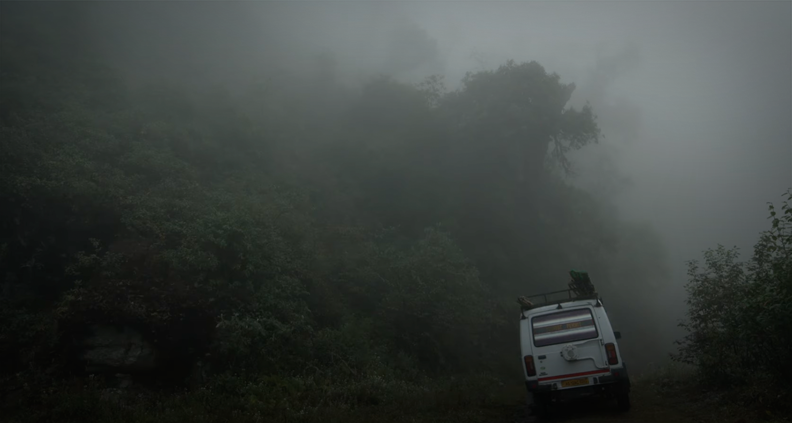
Vivek Maddala: I’m curious about the recording of the sound. The sound of fluttering wings is a prominent feature of the film. Was all or most of that sound that you captured on location, or did you do some of that in post production with foley and sound effects?
Anupama Srinivasan: Most of the sound you hear is from the location, and actually the sound of the moths flapping is very loud. We had very directional mics for that and we also had clip mics on the moth screen to capture small sounds on the canvas. We didn’t use any stock sounds. Everything was recorded on location. We did a little accentuation in the studio, especially for differentiating the different frequencies—like when we wanted to highlight the sound of different moth wings. We added layers with softer ones, or more sturdy ones. So that was something created more in the sound design.
Vivek Maddala: In terms of the multichannel audio, to create the content that would be used in the Dolby Atmos mix where you feel objects moving around and above you: Did you place microphones in different locations to capture the same events from varying locations? Or is that something you accomplished by surround panning in the mix?
Anirban Dutta: Actually, we used a 5.1-channel microphone to create the bed.
Vivek Maddala: So this is a mic with six different transducers/diaphragms?
Anirban Dutta: Yes, six diaphragms. The brand of microphone is Holophone. And then a [2-channel] stereo mic, which was a Senheiser MK6030. And then we had extremely unidirectional microphones to pick up specific sounds on the moth screen, and also clip microphones directly on the canvas. Importantly, they were all sync’d using two recorders that were recording with time code so that we knew exactly what sound was at what time looking at the metadata. So when we put it in Pro Tools, everything was matched.
So for the Atmos mix: Atmos opens like a three-dimensional room. Within that, it was very easy for us to open up the 5.1 bed track and we could pan things from that track, and then take the stereo signal and specifically place the sounds while looking at the images. And we also used the height feature for rain, thunder, and things like that because we also had unidirectional mics recording ambience. The resonance of thunder would be present in the 5.1 bed track, but we could specifically locate the unidirectional mic signal to a precise height location. We are a bit nerdy about sound, but I’m so glad we did this.
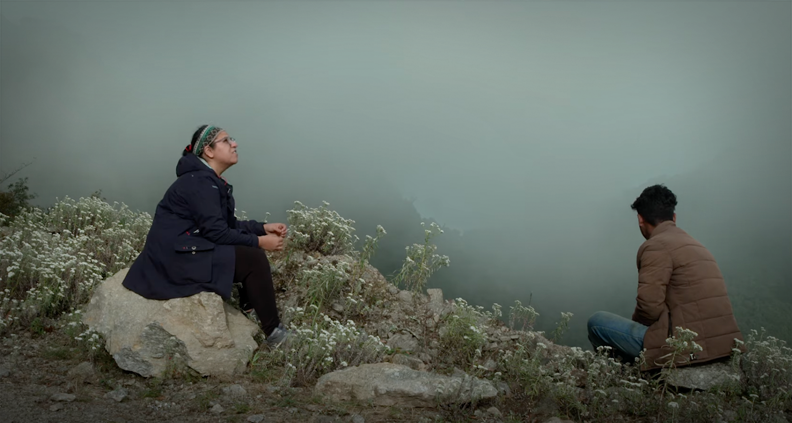
Vivek Maddala: It’s very difficult to record natural sound outside because wind hits a condenser or dynamic microphone and it causes the diaphragm to move to such an extent that it completely obscures the sound you’re trying to capture.
Anirban Dutta: It was an extremely difficult sound recording location because the wind was very high, but we had wind cancellation gear, multiple jammers, etc. We filmed over five months, so there was a lot of R&D that went in to it. After we had a rough assembly of the film, we went for ten days to record sounds again, at various elevations. For both Anu and me, sound is as much a part of the cinematic experience as visual image. You feel it viscerally, in the body, because of the sound. We had to work very hard to evoke that.
Also, we bought a small, inexpensive Zoom 360-degree recorder with a microphone, and again, we placed it in various locations. We used to leave it in the forest and come back and pick it up after one or two hours, to minimize human intervention as much as possible. It had a very flimsy wind shield, so we built a bigger wind shield around it. It had a hood much bigger than the microphone. If you ask me if there’s something you can buy in the market to do this, the answer is no—we created it!
Anupama Srinivasan: We also used it to capture thunder, which required repeated recordings.
Vivek Maddala: Thunder is quite difficult to record like that. If you have the gain turned up on the microphone preamp to capture quiet sounds, something occurring suddenly with a high SPL (sound-pressure level) will overload the preamp.
Anirban Dutta: That’s absolutely correct. One of the beautiful things about documentaries is the idea of repetition. Coming philosophically to the scientific process: the form of the film, the process of the film, and the process of the science all ran parallel to each other. And because the scientists were doing this work, which is repetitive, it opened up many cinematic possibilities beyond the core idea of following the story. It was a big challenge to make the story more sensorial and immersive.
Vivek Maddala: Apart from the macroscopic shots, a lot of the visual shots in the film are stationary, so they feel observational. It’s as though you’re inviting the audience to make their own editorial choices about what they’re going to focus on. And these shots have a large depth of field. It feels like you’re enticing the audience to be observers alongside the film’s protagonist.
Anupama Srinivasan: Our idea was to portray the moths and the human beings as part of a larger world and not to isolate them. We have this joke that we wanted to treat the moths and the human beings with dignity—so we don’t want to go too close to them. Our overall philosophy was: How do we see human beings as part of nature? We didn’t want to use a telephoto or something to isolate them in the picture. So that kind of treatment was very important, so the depth of field was well-thought-out.
For the static shots: that’s something we arrived at. In the beginning of the process, we did have more camera movements. Slowly, we realized this was not taking us to the heart of the film. And in editing, a lot of that got left out. The static, long takes were the ones that intrigued us, that allowed us to make these different narratives in our own heads. And then the whole film took this on. For example, when you saw the film, you picked up more strongly on this idea of the scientific process. Somebody else sees the class dynamics because they’re coming with their preconceptions. Because the film is open, it doesn’t impose a particular story or idea. It explores many ideas, and it’s up to you how you want to formulate your own story or find your own politics in that.
Global Media Makers (GMM) is an in-depth, intensive artist development exchange program that produces residencies for international mid-career writers, directors, and producers in film and television. GMM fosters networks between U.S. industry leaders and mid-career film and TV professionals around the world. GMM is a cultural diplomacy initiative of the U.S. Department of State’s Bureau for Educational and Cultural Affairs (ECA) and implemented by Film Independent.
